The fourth most popular post from 2017 was more about car repairs than my friend Howard Tayler’s popular web comic, Schlock Mercenary. In fact, mostly what they had in common was the title. But, I enjoyed being able to help prove the universality of Howard’s rules for mercenaries.
—————–
MAXIM 32: ANYTHING IS AMPHIBIOUS IF YOU CAN GET IT BACK OUT OF THE WATER
August 4, 2017
Last week at Boy Scout camp, I had a few car issues. Okay, I dumped my Honda Civic into the creek, nose first. My friend Howard Tayler wrote the title of this post for his web comic Schlock Mercenary. I put it to the test.
As I arrived home on Friday night, my broken car sat at the curb waiting for me. I’d been able to drive it from the scene of the crash to the highway. The check engine light had come on. My diagnostic tool couldn’t read the codes. (Why did I have a check-engine-reading tool in my car on a camping trip? Don’t ask.) It seemed safest to have it towed home.
I got up Saturday morning and headed out to check out the damage. There was a big hole in the bumper. Popping the hood, I could see that the AC condenser was pressed into the radiator. Which in turn was pressed into the fan. My car would run, but not for long if I tried to drive it without repairing it. It certainly wouldn’t have made it the 40 miles from Spanish Fork canyon to Pleasant Grove.
I cleared a space in front of my garage, put the front of the car on jack stands and went to work. The first part of any repair is disassembly. It’s like peeling an onion. . .and then putting it back together. The bumper, or rather the cowling over the bumper, came off pretty easily. Honestly, most of the rivets were popped from the dip in the creek.
The actual bumper is a big piece of steel that goes across the front of your car. It sort of looks like a curved bow protruding out to protect your car. Mine? It was the piece that pressed the condenser in. It was mostly horseshoe shape. It had done its job and died in the effort. It took the bulk of the impact. It came off surprisingly easily.
Now to the real work. The compressor looks like a miniature radiator. It is supposed to be flat. Mine was more bowl shaped. I didn’t remove it yet, though. It was full of freon. I didn’t want to remove it until I was ready to refill the AC system. Instead, I swung it out of the way. Kind of like a barn door. I heavily damaged, broken barn door.
Behind the compressor was the actual radiator. It was also mostly bowl shaped. I drained the radiator and got about a pint of fluid. The car takes 1.8 gallons. It had lost a little fluid. Next, I started disconnecting the hoses. There are 6, which wouldn’t be a problem if the clamps weren’t hidden behind other components. I made a mental note of where each hose and each electrical connection went.
The back of the radiator has two fans. These were pressed up tight against the bent radiator. As I pulled them off, they spun easily, apparently unharmed. Stepping back, I felt pretty confident that disassembly was done. Not too bad considering the possibilities. I needed a new bumper, a new compressor and a new radiator.
Towing my car from the canyon to my house cost $500; $300 to pull it out of the creek and $200 to load it on a truck to my house. Total parts for the fix were going to come in about $400. By the way, don’t try this at home. Well, if you are a mechanic, or have a neighbor who is, you can. Taking my car to a shop would have probably run into $1000 or $1200 for parts and labor in addition to towing.
Any job, no matter how small, is an excellent excuse for a new tool.
I almost had everything I needed. I ended up buying a vacuum pump to evacuate the AC system prior to refilling with freon. I also had to buy the freon and some more plastic rivets to attach the bumper cover.
It took a couple of days to get all the parts in. My neighbor and his son came over to help. Cameron, my neighbor’s son did a lot of the work on the radiator. Jonathan, his dad did the work on the AC and my part was the body work.
A Honda Civic that is missing the cowling in front looks a lot like a wannabe Mustang. My kids thought it was cool. I lived in fear of catching a rock in that soft aluminum. Tomorrow, I’ll put the cowling back on and call the repair complete.
One week
Two junk yard trips
Three trips to the auto parts store
14 Times I wished I’d learned to swear
The best part of the entire process was proving the validity of my friend Howard’s Maxim 32. Yep, I got it back out of the water. It proves it was amphibious. I think I may combine that Maxim with #11: Everything is air-droppable at least once, and figure once was enough.
This is the final post to a multiple part story about my misadventures at scout camp. I plan a rare Saturday post tomorrow to include the picture story.
Here are the other parts of the story
I’m Okay. I’m Okay. . .I’m Not Okay (Sliding off the road)
If The Good Lord is Willing And the Creek Don’t Rise (Yup, it ended up in the creek)
It’s What We Do (Okay, NOW what do I do? I figure out how to get out of it)
Maxim 32: Anything is Amphibious If You Can Get It Back Out Of The Water (a hat tip to my friend Howard Tayler, who wrote the headline)
That Doesn’t Go There – The Long Delayed Picture Essay
Rodney M Bliss is an author, columnist and IT Consultant. His blog updates every weekday. He lives in Pleasant Grove, UT with his lovely wife, thirteen children and grandchildren.
Follow him on
Twitter (@rodneymbliss)
Facebook (www.facebook.com/rbliss)
LinkedIn (www.LinkedIn.com/in/rbliss)
or email him at rbliss at msn dot com(c) 2017 Rodney M Bliss, all rights reserved
This week I will be counting down the top five most popular posts from the past year. Coming in at #5 is STAW: Chronological Chaos OP – An Unbeatable Build? Star Trek Attack Wing (STAW) is a miniature tabletop game based in the Star Trek universe. My brother got me started on the game a couple of years ago. This post talks about how my son and I figured out a way to win a particular Organized Play (OP) event.
It was so popular because the STAW online community is pretty active. I posted a link to the story in the STAW forums and it generated a fair amount of discussion of whether or not the fleet we built was truly unbeatable.
If you are unfamiliar with STAW, there’s a link to a short primer at the beginning of the story.
Tomorrow I’ll link to the 4th most popular post from 2017 which combines smashing cars with a certain online carbosilicate life form.
————————————————-
STAW: CHRONOLOGICAL CHAOS OP – AN UNBEATABLE BUILD?
This post assumes an understanding of Star Trek Attack Wing (STAW). Read a brief introduction to it here.
Last month I attended the Chronological Chaos OP at our Friendly Local Game Store (FLGS.) The FLGS I play at plays Faction Pure. We were also playing “old rules.” So, no subfactions. Two of my sons also attended. I played the Independent Faction. My older son played Romulan. But, it was the Federation Fleet that my younger son ran that was the unbeatable build.
It’s obviously pretty bold to call a build unbeatable, especially when you are limiting the build to a single faction. I’ll go over the build and then walk through the first Activation (movement) Phase. I think it would be difficult to prevent that first move and it would be nearly impossible to catch him after the first turn.

Chronological Chaos OP
In this scenario, your fleet arrives in an unexplored sector of space to investigate a series of subspace anomalies causing large scale time fluctuations across the quadrant. As you arrive, your sensors detect an enemy fleet coming out of warp nearby. You have direct orders to investigate the anomalies to figure out their source, but you cannot simply ignore your most hated enemies while doing so. As you engage in combat and start investigating these anomalies, you realize that they are tears in space and time which bridge multiple universes!
Essentially, you have to fly to each of four spots in the playing area as quickly as possible, without having your fleet destroyed. Chronological Chaos has multiple victory conditions.
- Any ship has four mission tokens at the end of the round. (Meaning it has visited each of the four objectives)
- One player is eliminated.
- The time limit is reached.
That means that the game is over if someone gets to all four spots, or if one fleet destroys their opponent’s fleet, or if the players take an hour and neither player has eliminated the other or made it to all four spots We built the Federation Fleet specifically to accomplish goal #1. We were not interested in fighting. In fact, because only ships who have gone through the same number of checkpoints can attack each other, the goal was to prevent the opponents from even being able to interact with “the Rabbit,” our fastest ship.
The Rabbit Build
U.S.S. Raven [U.S.S. Raven] (16) <– The Rabbit
Jean-Luc Picard [U.S.S. Stargazer] (4)
Adm Maxwell Forrest [Enterprise NX-01] (3)
Picard Maneuver [U.S.S. Stargazer] (5)
William T. Riker [U.S.S. Enterprise-E] (5)
Phlox [Enterprise NX-01] (2)
Pavel Chekov [U.S.S. Reliant] (3)
Transwarp Drive [U.S.S. Excelsior] (3)
Total (41)
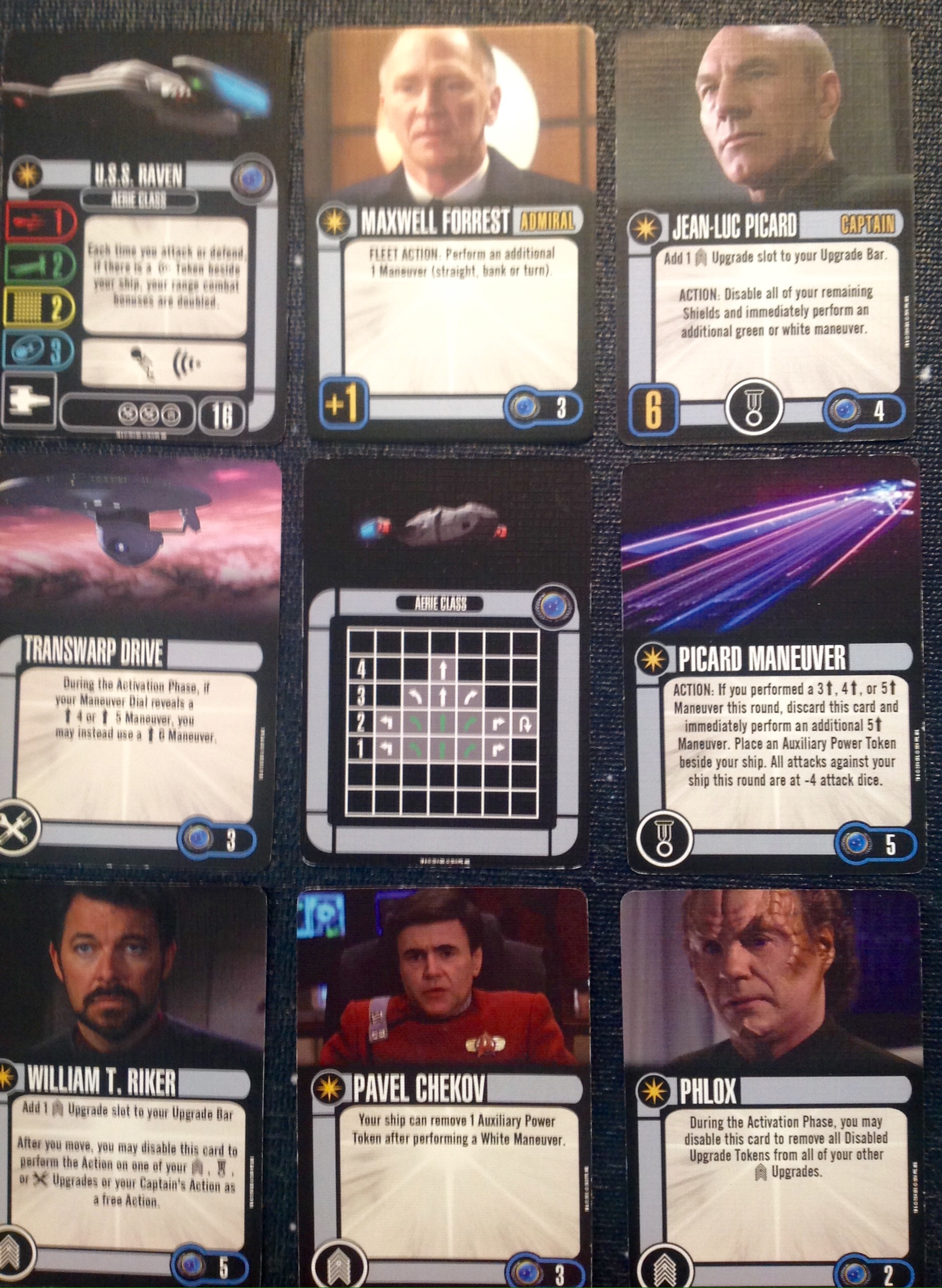
Prometheus Class [U.S.S. Prometheus] (28)
Benjamin Maxwell [U.S.S. Yeager] (4)
Defy Orders [U.S.S. Lakota] (4)
Automated Distress Beacon [U.S.S. Constellation] (3)
Total (39)
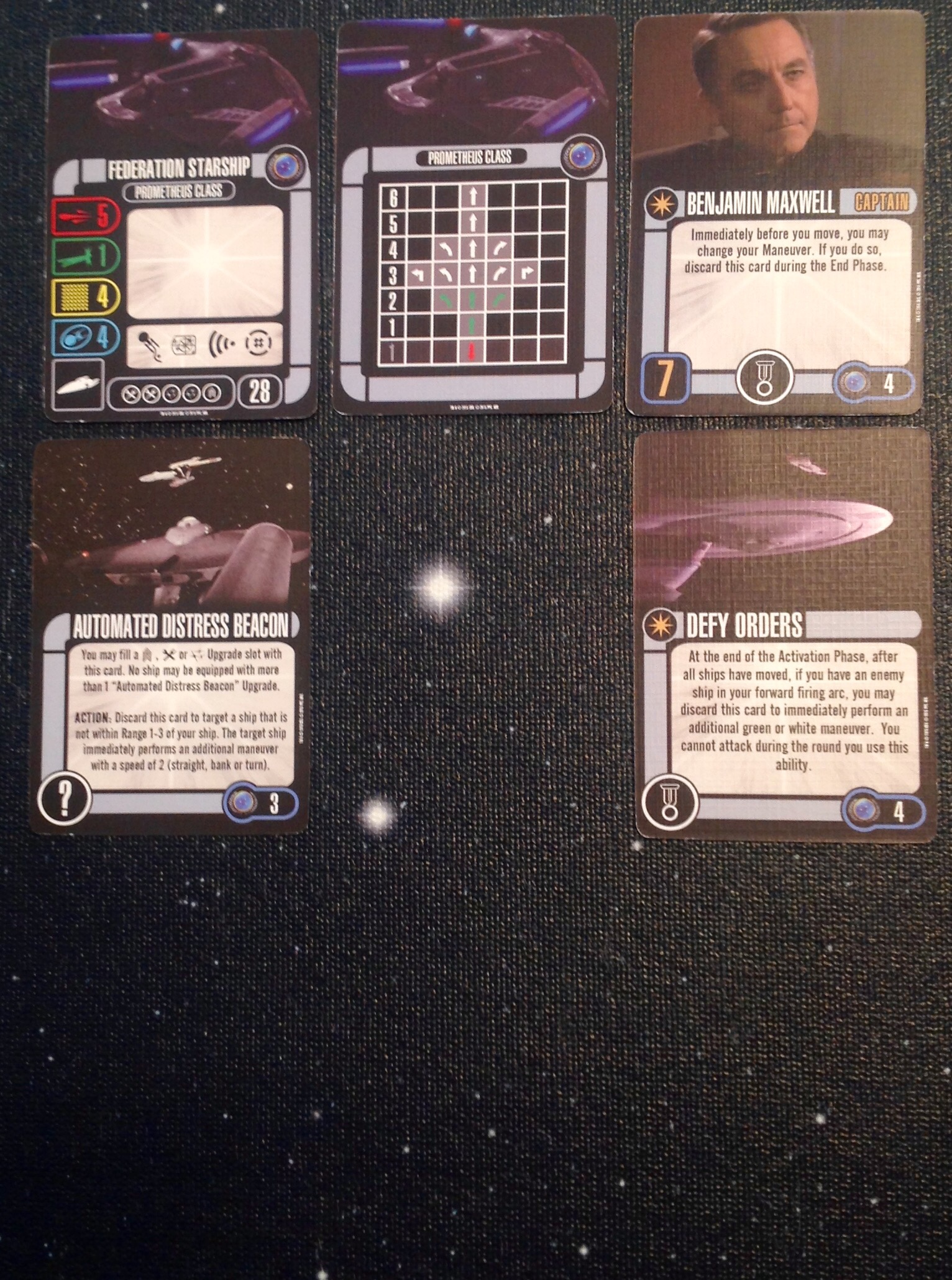
U.S.S. Hathaway [U.S.S. Hathaway] (22)
Benjamin Sisko [Deep Space 9] (4)
Flag Officer [U.S.S. Intrepid] (4)
Montgomery Scott [H.M.S. Bounty] (4)
Wesley Crusher [U.S.S. Montgolfier] (5)
Thruster Array [U.S.S. Montgolfier] (3)
Automated Distress Beacon [U.S.S. Constellation] (3)
Total (45)
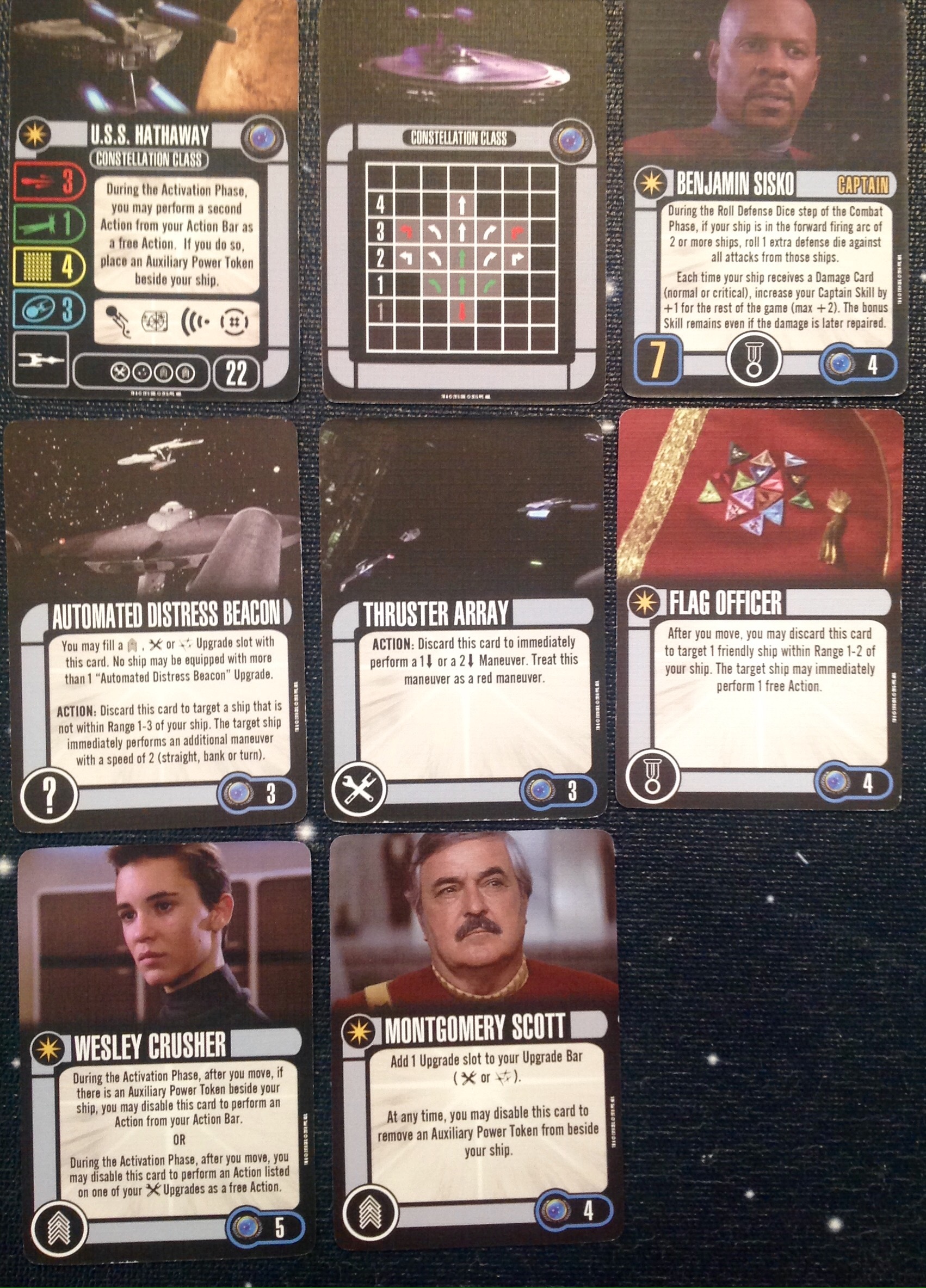
Emergency Power (5)
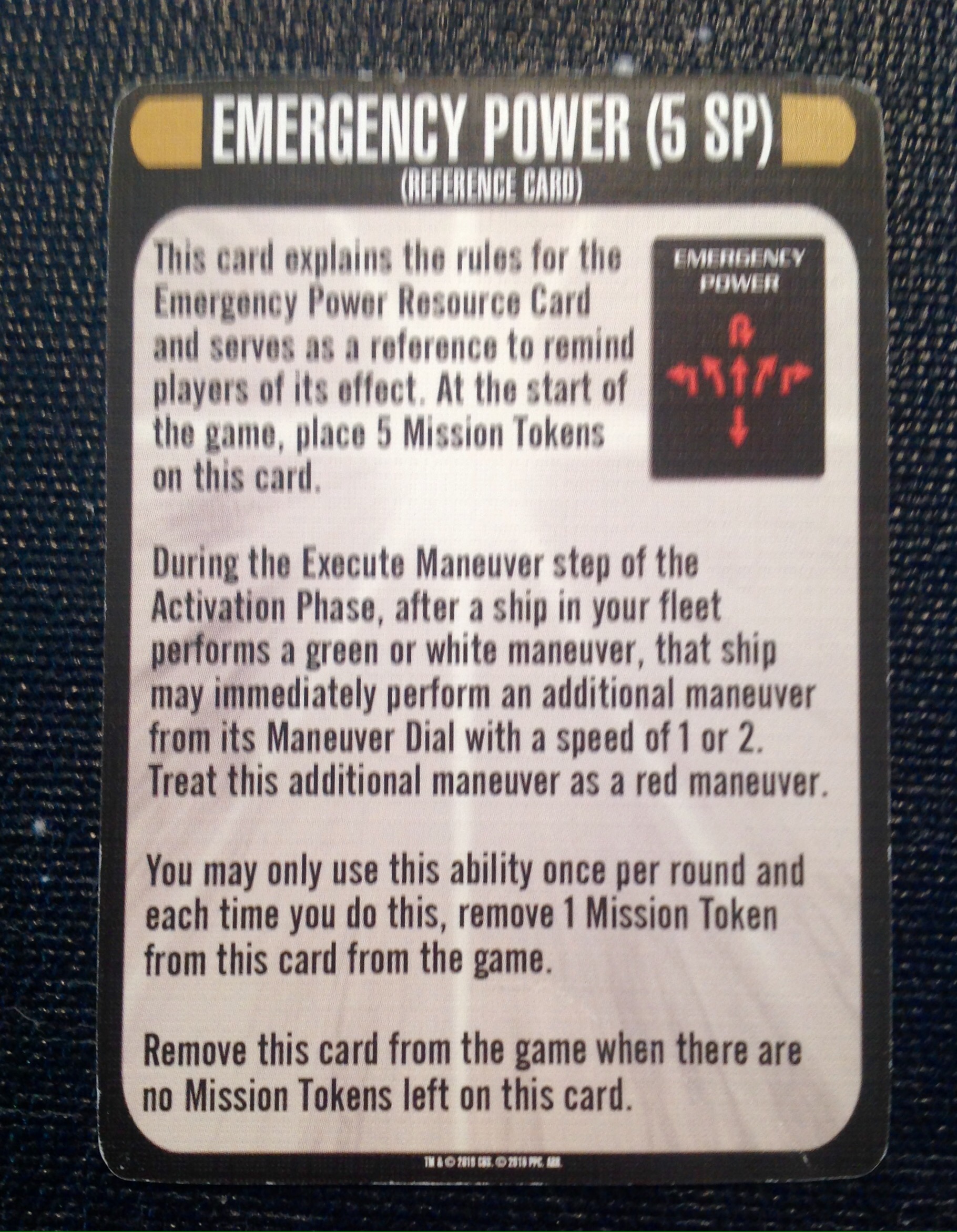
Fleet total: 130
Generated by Space Dock for iOS
http://spacedockapp.org
Flying The Rabbit Build
Yes, it’s the USS Raven, but we named it the Rabbit. The goal was to get the Rabbit as far ahead as possible, as quickly as possible. The Prometheus-class (let’s just call it the Prometheus, even though it’s not the named ship) is a fast ship in its own right, but mostly it’s for blocking. The Hathaway is almost a throwaway. but, it still has an important role to play. The resource, Emergency Power doesn’t figure into the opening move, but is useful in the middle or late game if needed.
First a word on the captains. Other than Picard’s ability, the other captains’ abilities are not important. The important thing is that all three captain have the same skill level. Picard’s 6 gets a boost of 1 from Admiral Forrest. It’s possible to use the other two captains to attempt to distract your opponent before you start playing.
The same thing for the Ships’ abilities. They are really immaterial. The important characteristics are the upgrade slots and most importantly the maneuvers that each ship is capable of.
Assuming you are playing from the Southern Edge, The Rabbit sets up exactly 13″ from the Western edge and against the very Southern edge. The Prometheus sets up 11″ from the East edge and 4″ from the Southern Edge. The Hathaway sits just West of the Prometheus.

By having all captains at a Skill 7, the Federation player gets to move all his ships together and in any order. The Prometheus moves first by going STRAIGHT 6. This puts it more than Range 3 away from the Rabbit.

For his Action, he uses Automated Distress Beacon to move the Rabbit STRAIGHT 2.

Next up is the Hathaway. The Hathaway moves STRAIGHT 1. This puts it within Range 2 of the Rabbit.

Hathaway now discards Flag Officer allowing it to use an Action on a ship within Range 2. It targets Captain Picard’s captain Action.
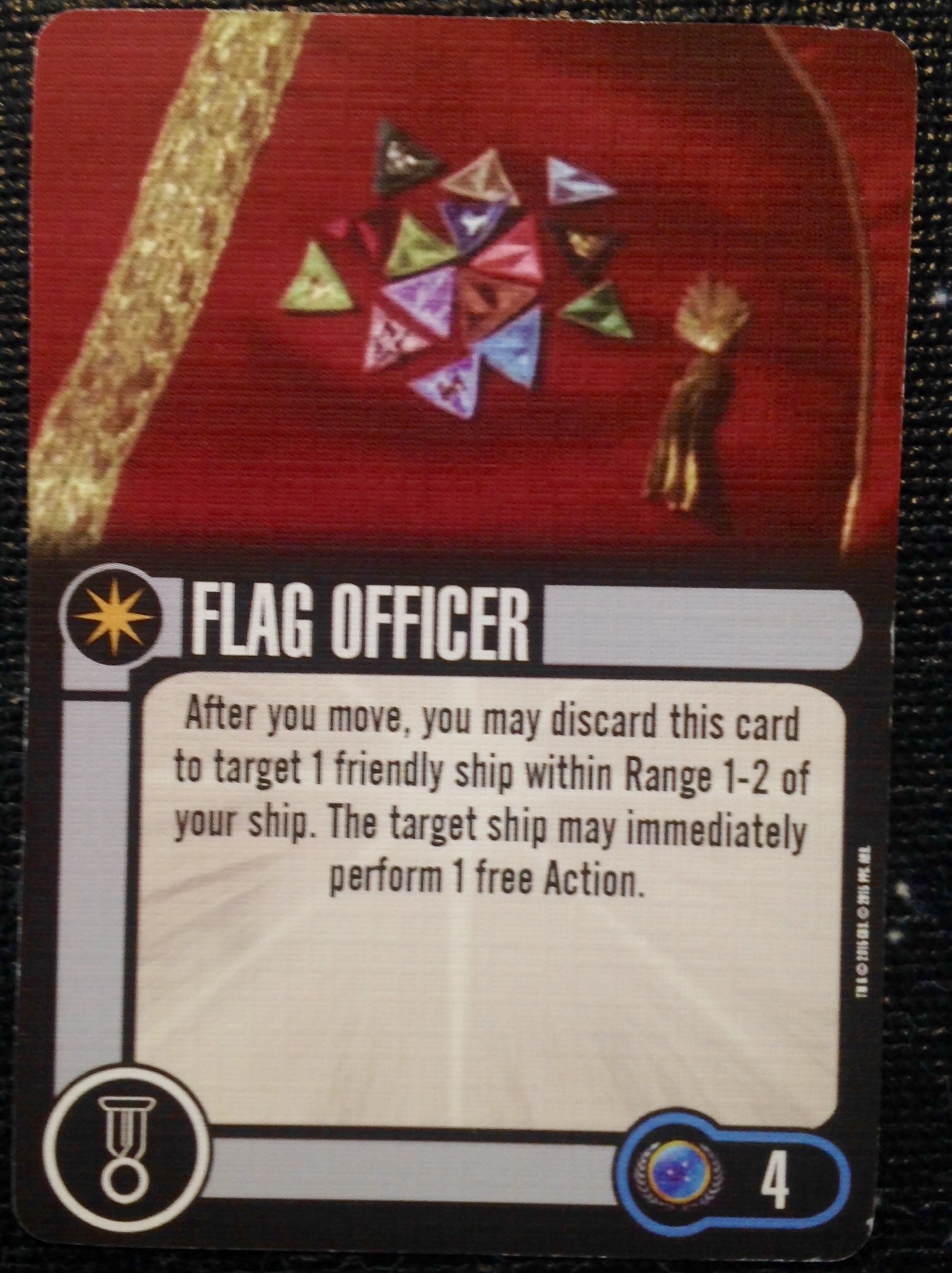
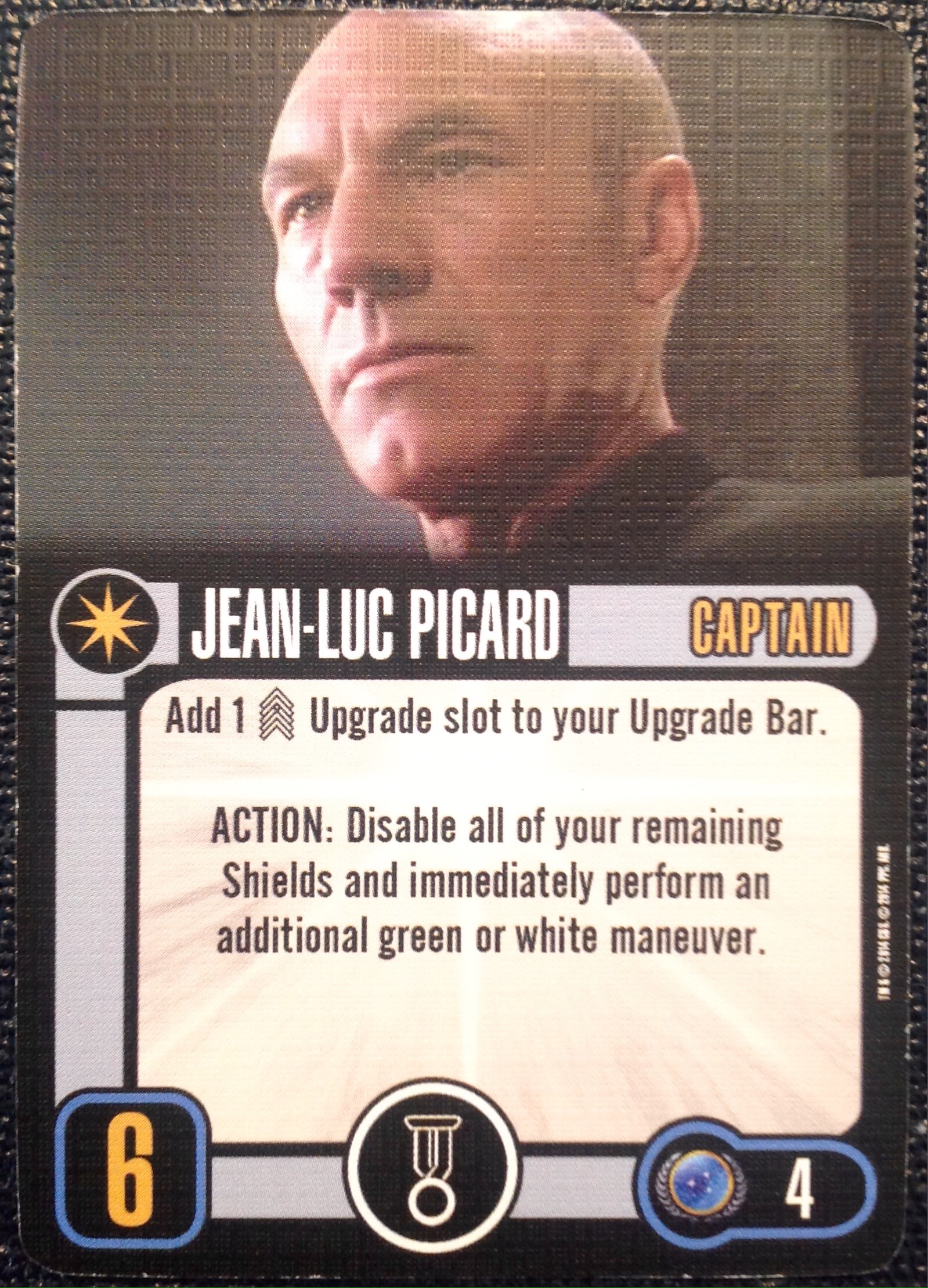
This allows the Rabbit to move STRAIGHT 4. At this point Hathaway disables Wesley Crusher to immediately use one of its Tech Upgrades. In this case it discards Thruster Array to move the Hathaway REVERSE 2 and take an Auxiliary Power Token (APT.)
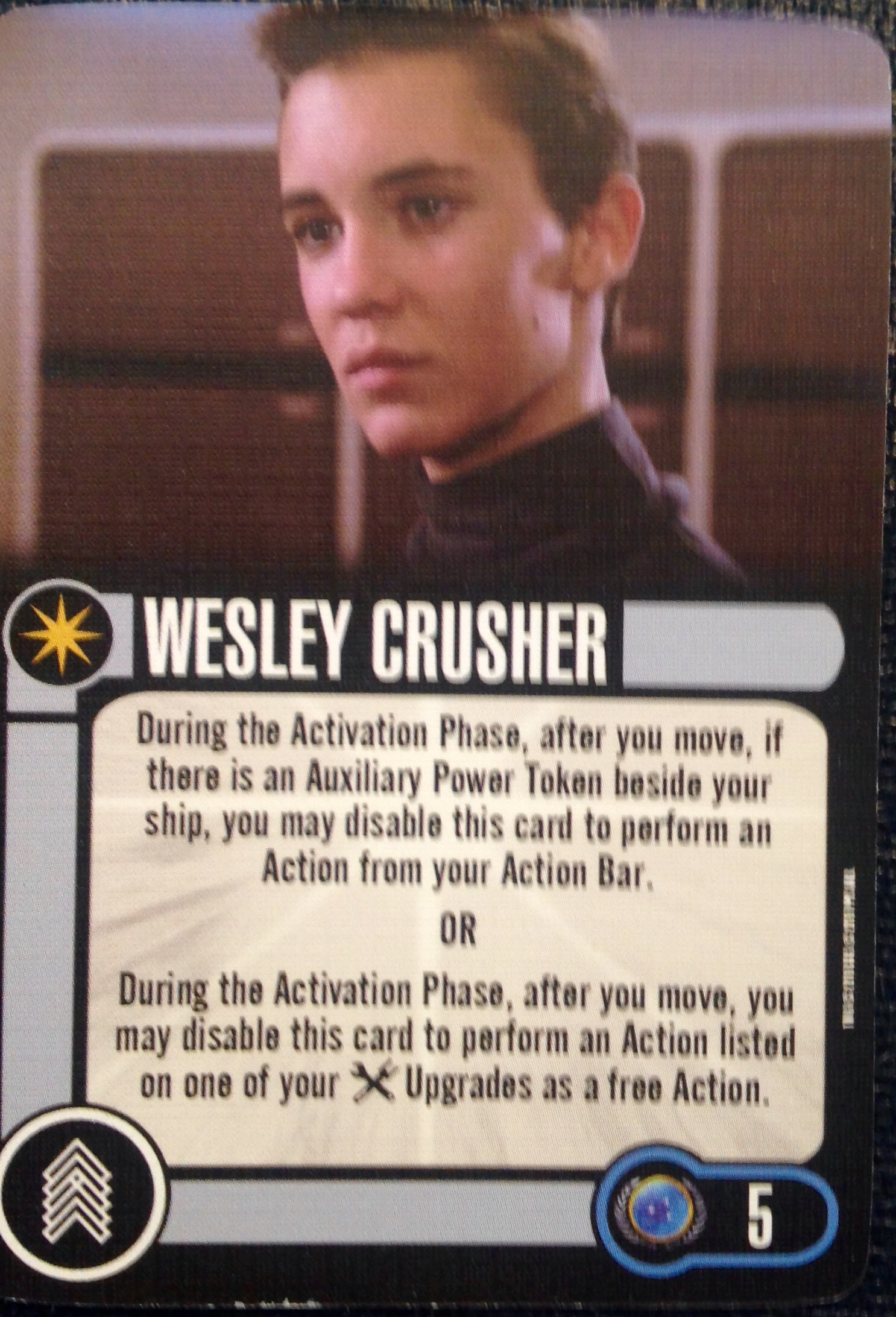
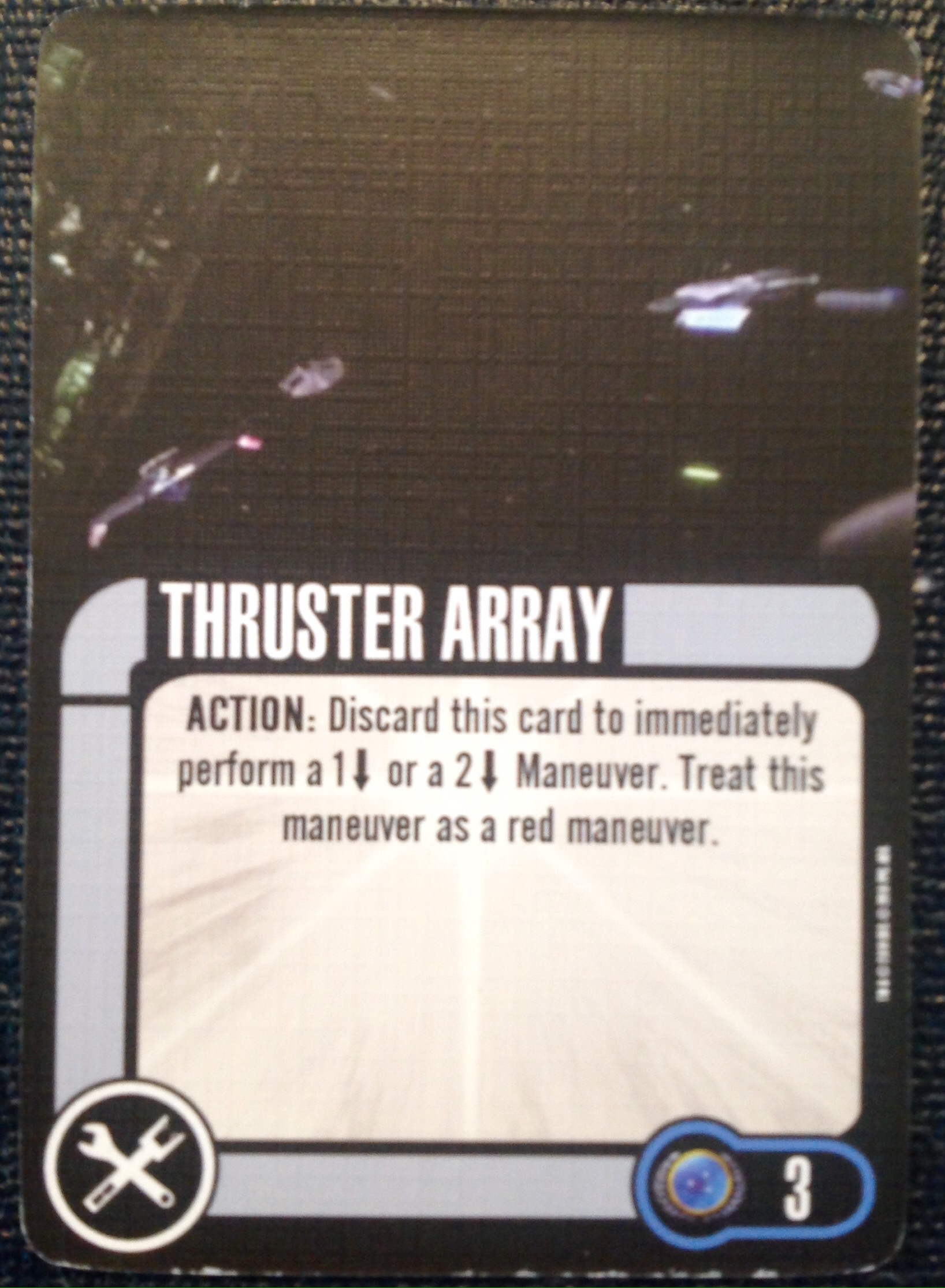
This puts the Hathaway more than Range 3 away from the Rabbit.

The Hathaway isn’t done. Next, it Disables Montgomery Scott to remove the Aux Token.
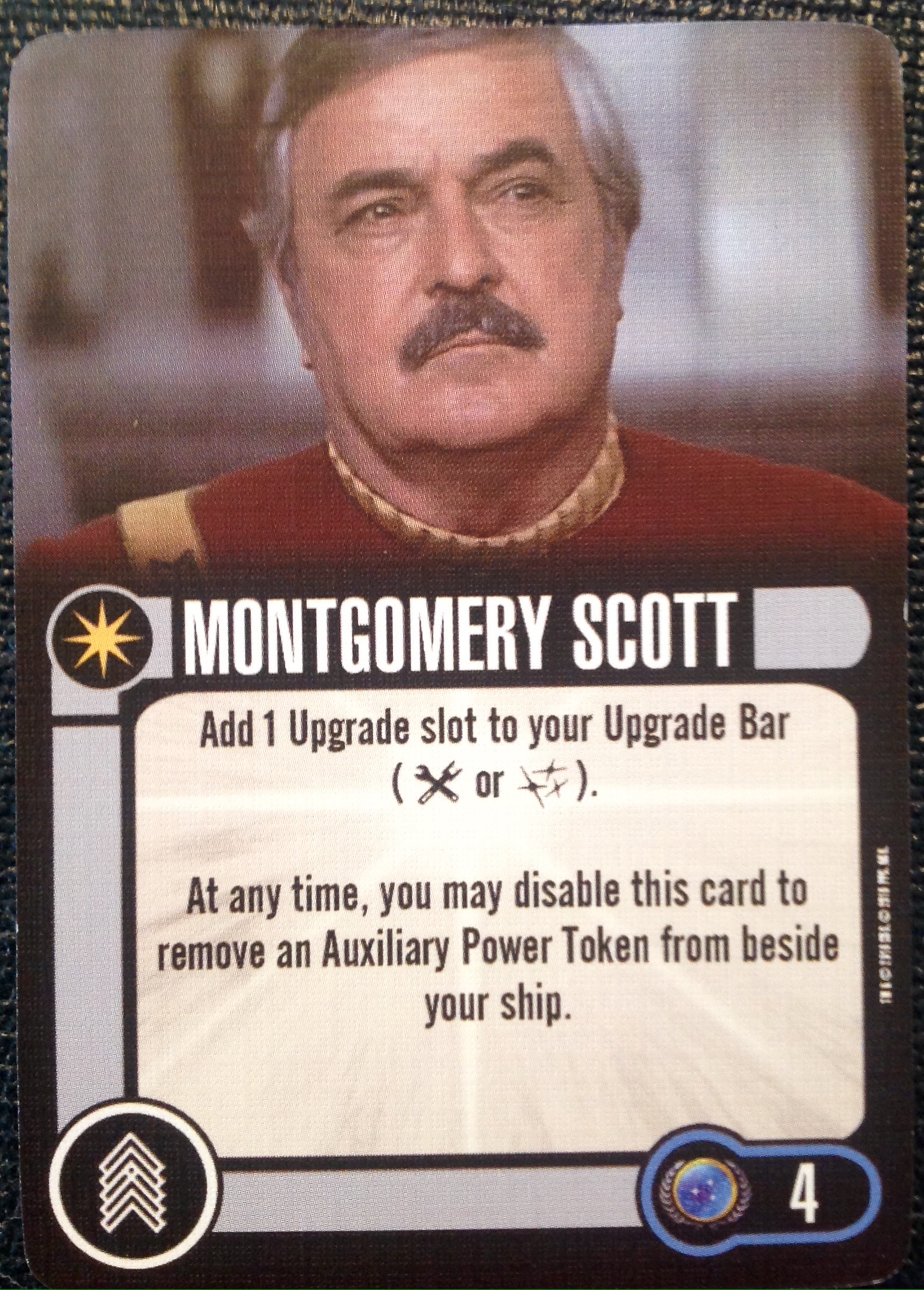
With the Aux Token gone and being more than Range 3 from the Rabbit, the Hathaway can activate it’s Action. It uses Automated Distress Beacon to move the Rabbit in a TURN 2 to the right.
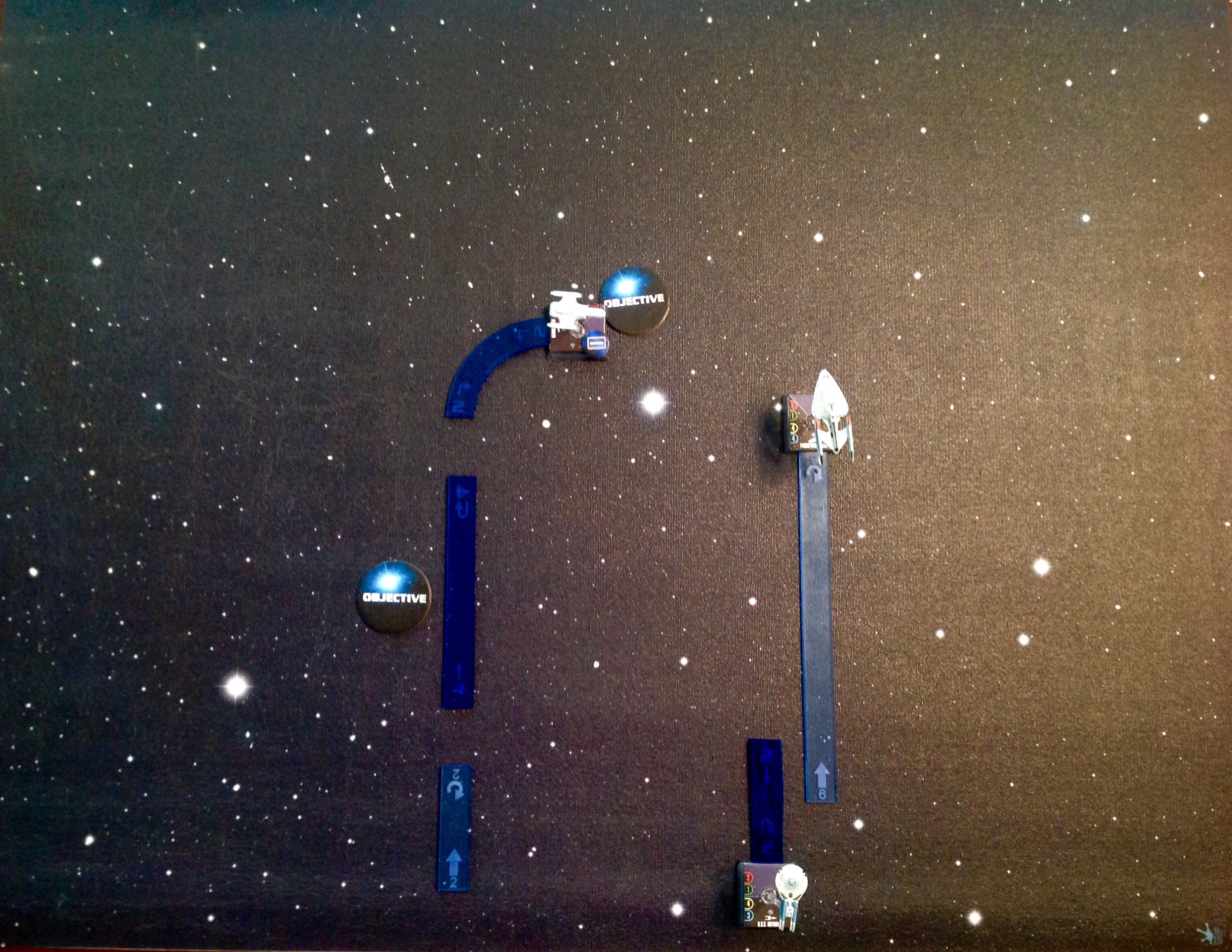
It is now the Rabbit’s turn to move and it’s already through the first portal. In Chronological Chaos, the first portal is in a set location. The second portal could be anywhere on the board. I have placed the second portal in what I consider the worst possible location for the Rabbit. As you’ll see, the Rabbit is going to have to reverse course to get back to the second portal.
The Rabbit first does a COME ABOUT 2.
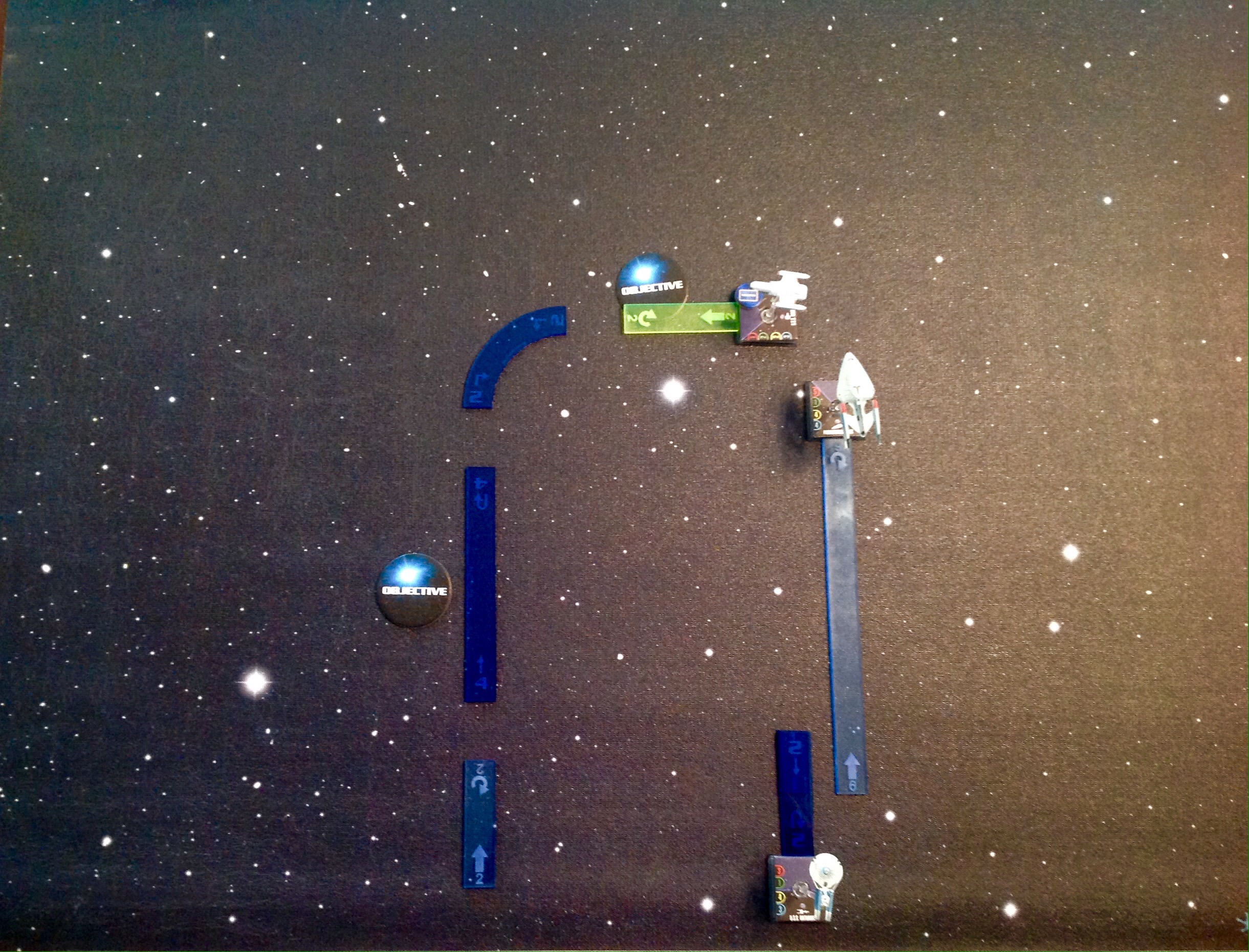
For its Action, the Rabbit uses Admiral Forrest’s Fleet Action to BANK 1 to the left.
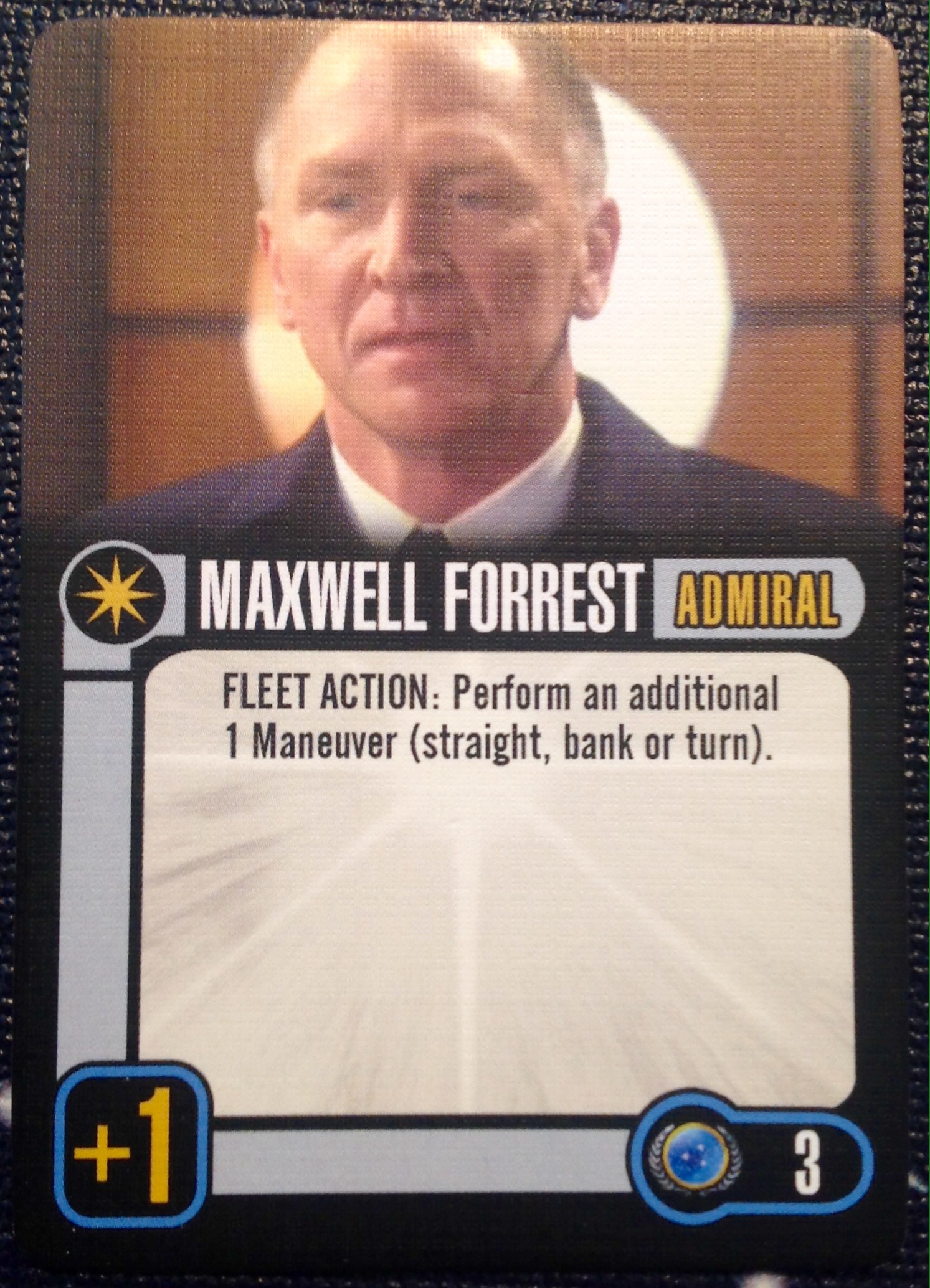
This aligns the Rabbit toward the second portal.
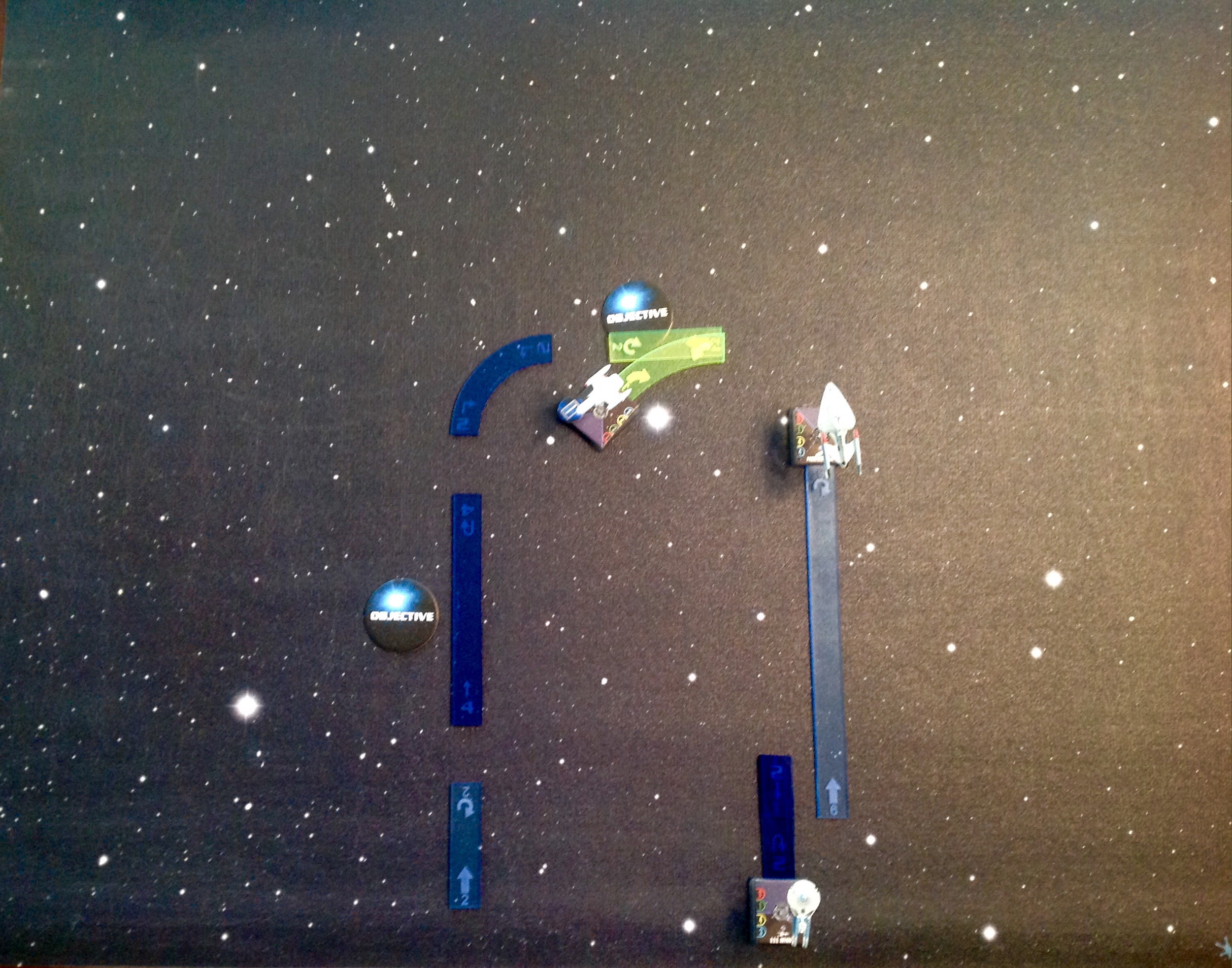
Next, the Rabbit disables William Riker to allow it to perform a free Action. Rabbit performs the Picard Maneuver to move STRAIGHT 5.
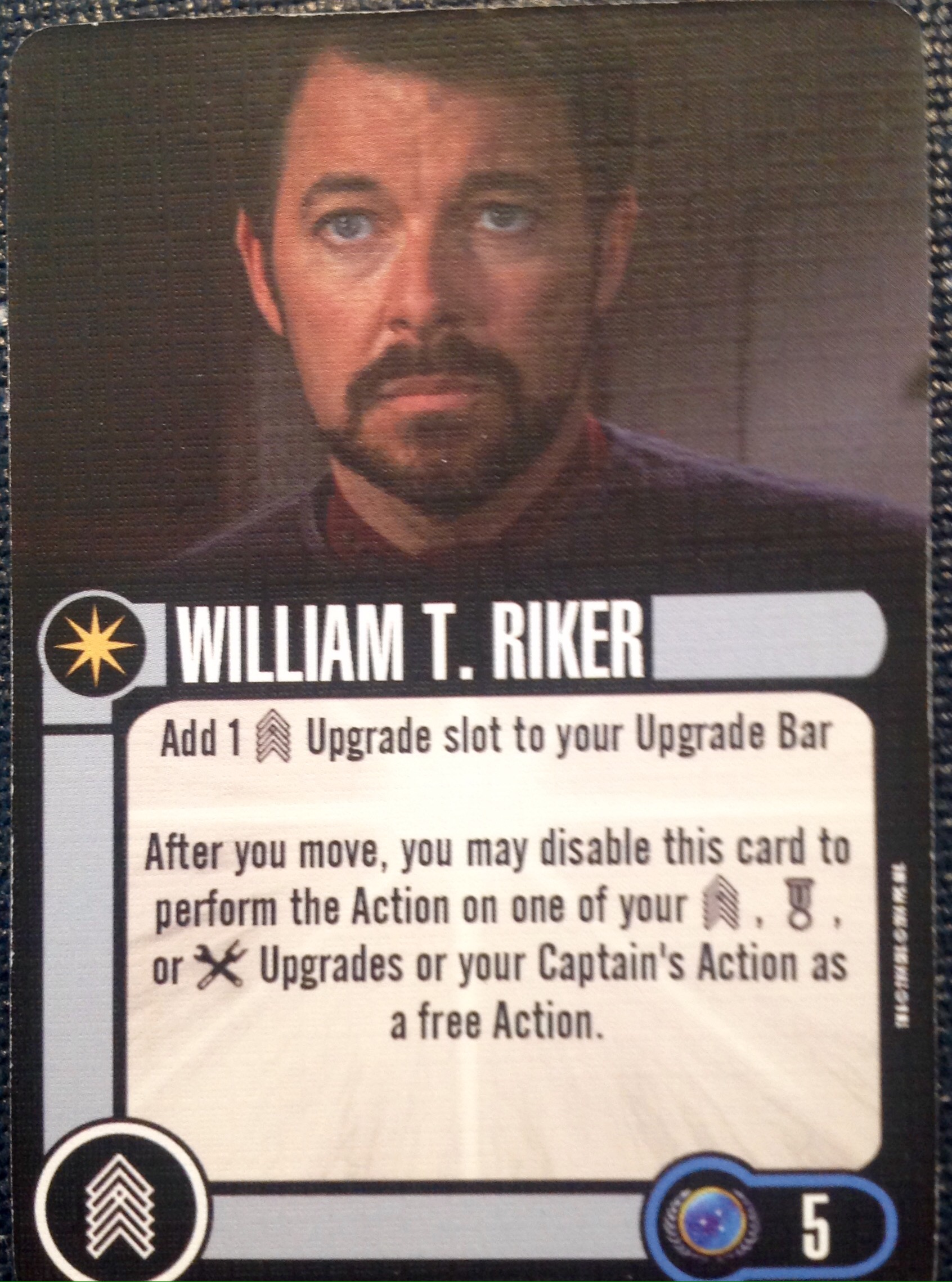
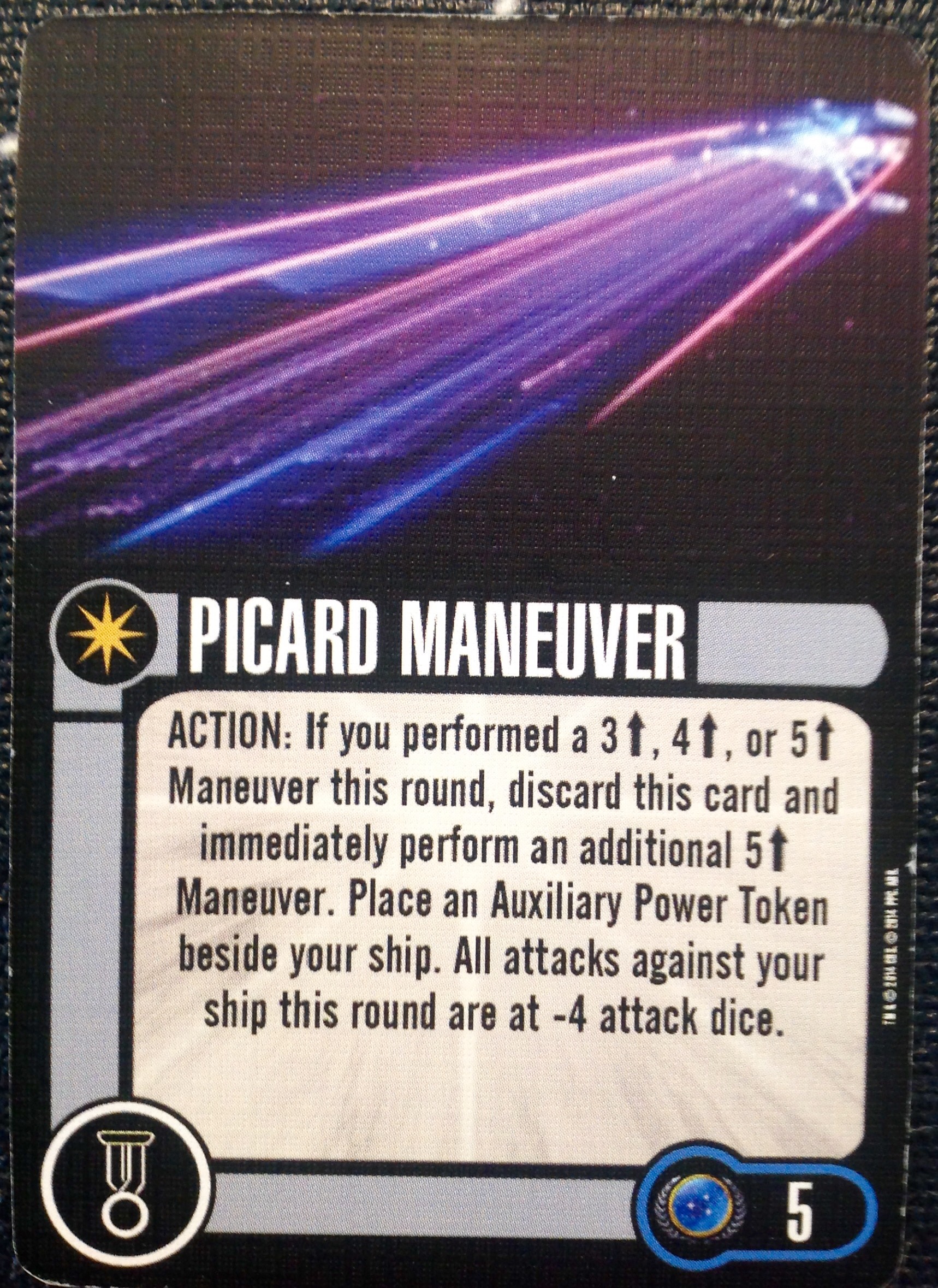
The Rabbit is done moving and is now through portal 2.
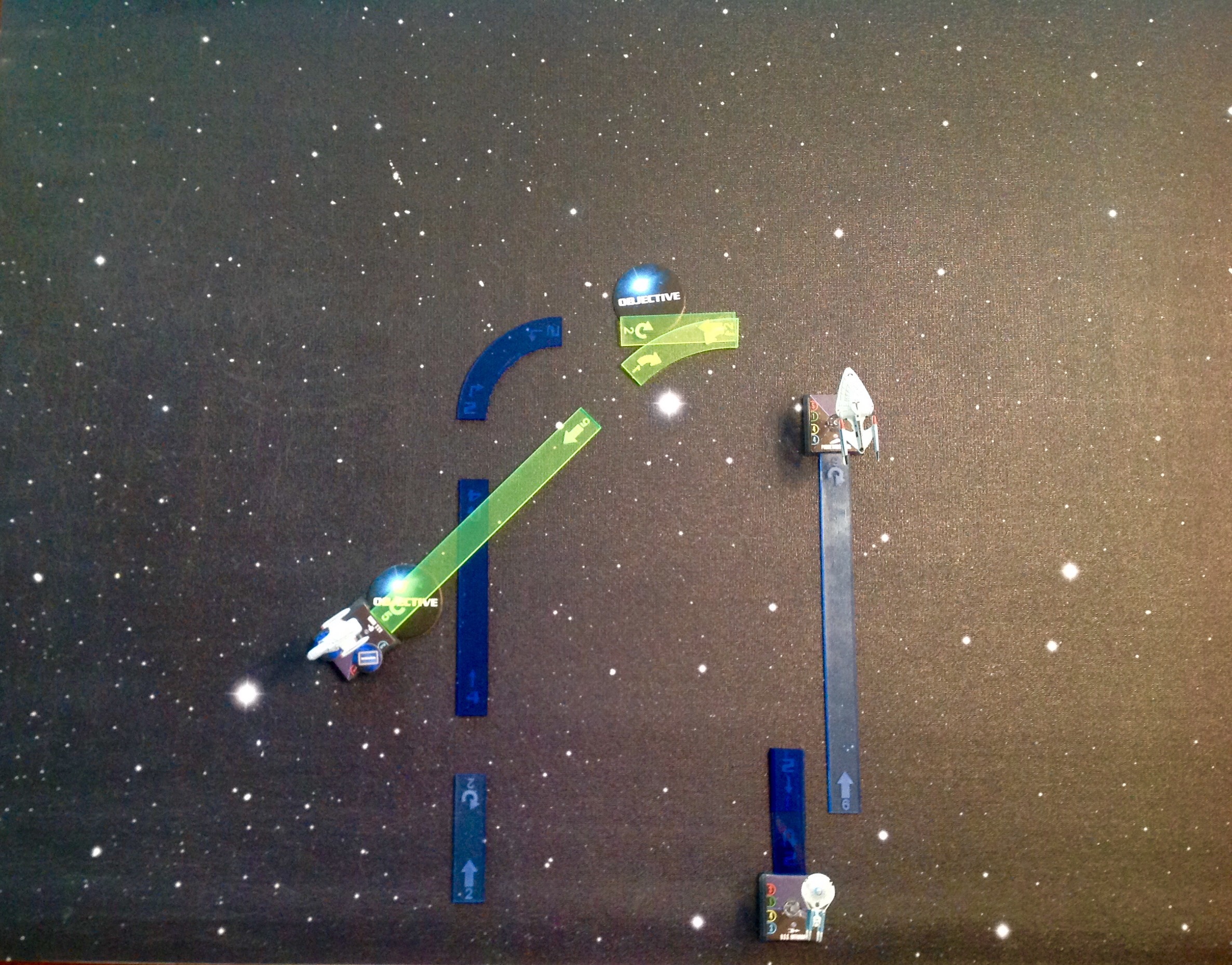
But, the play is not yet over. At the end of the Activation Phase the opposing player will undoubtably be close to Portal 1. And Prometheus will likely be within the forward firing arc of an enemy ship. Prometheus now discards the Obey Orders upgrade to allow it to TURN 3 to the left to move through the first portal.
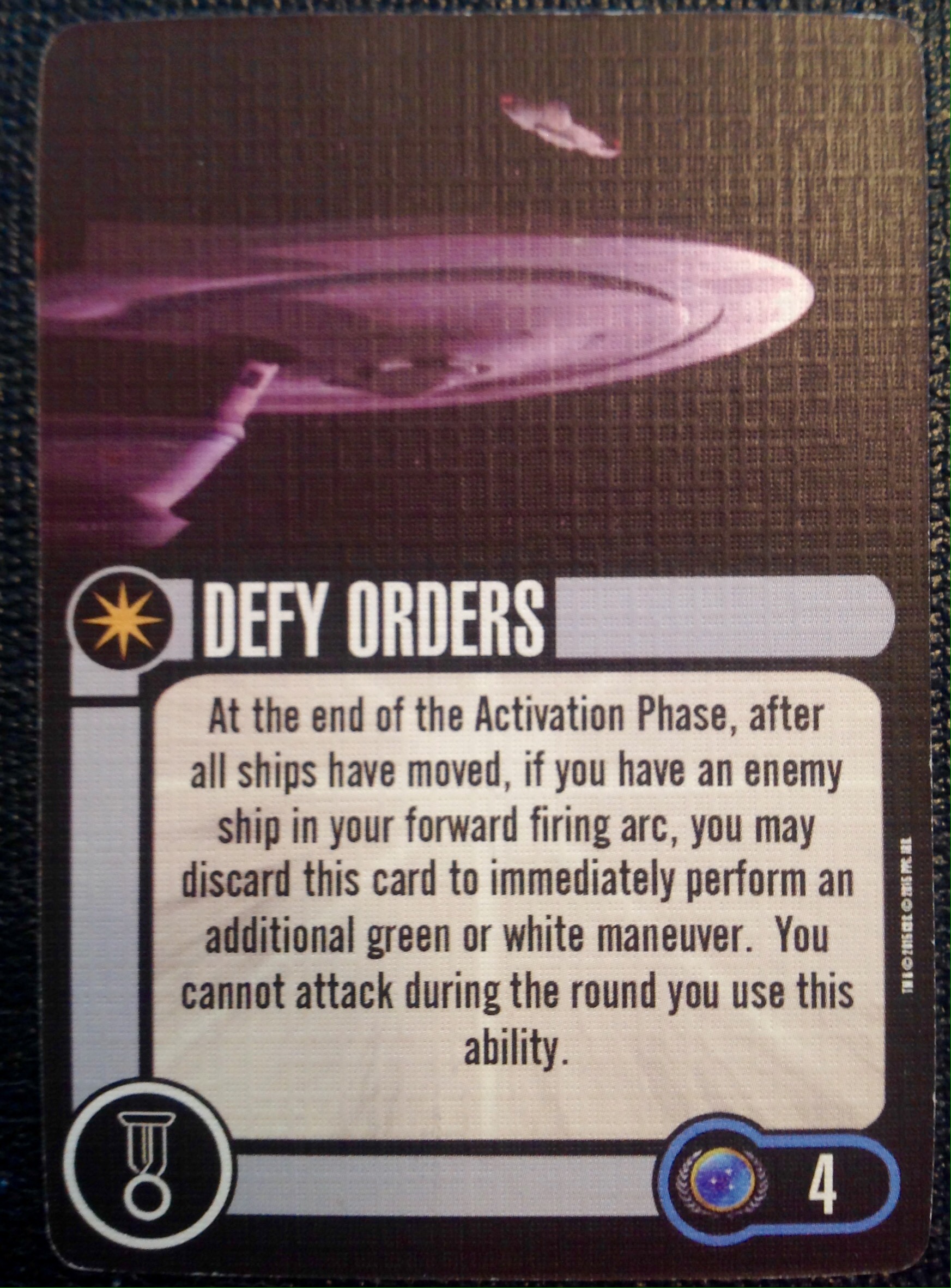
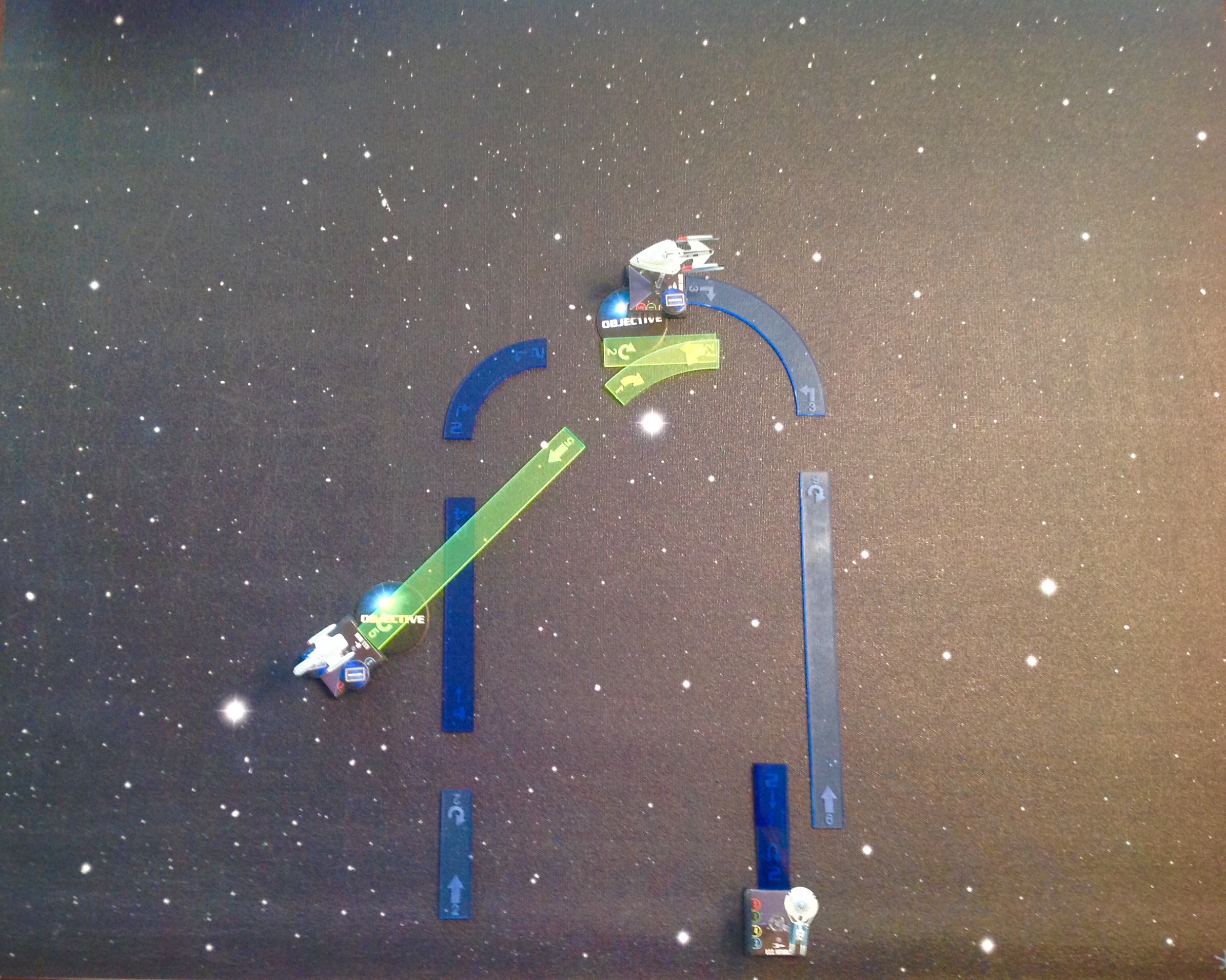
The Race To The Finish
So, at the end of the first Activation Phase, the Rabbit Build has one ship in the original location. One ship has gone through one portal and the second ship, the Rabbit, is through two portals. The Rabbit has moved the equivalent of 20, about 30″. As the Rabbit makes its run to the finish, the ship will be able to move STRAIGHT 4 and the Transwarp Drive will bump that by STRAIGHT 2, for a base speed of STRAIGHT 6 each turn.
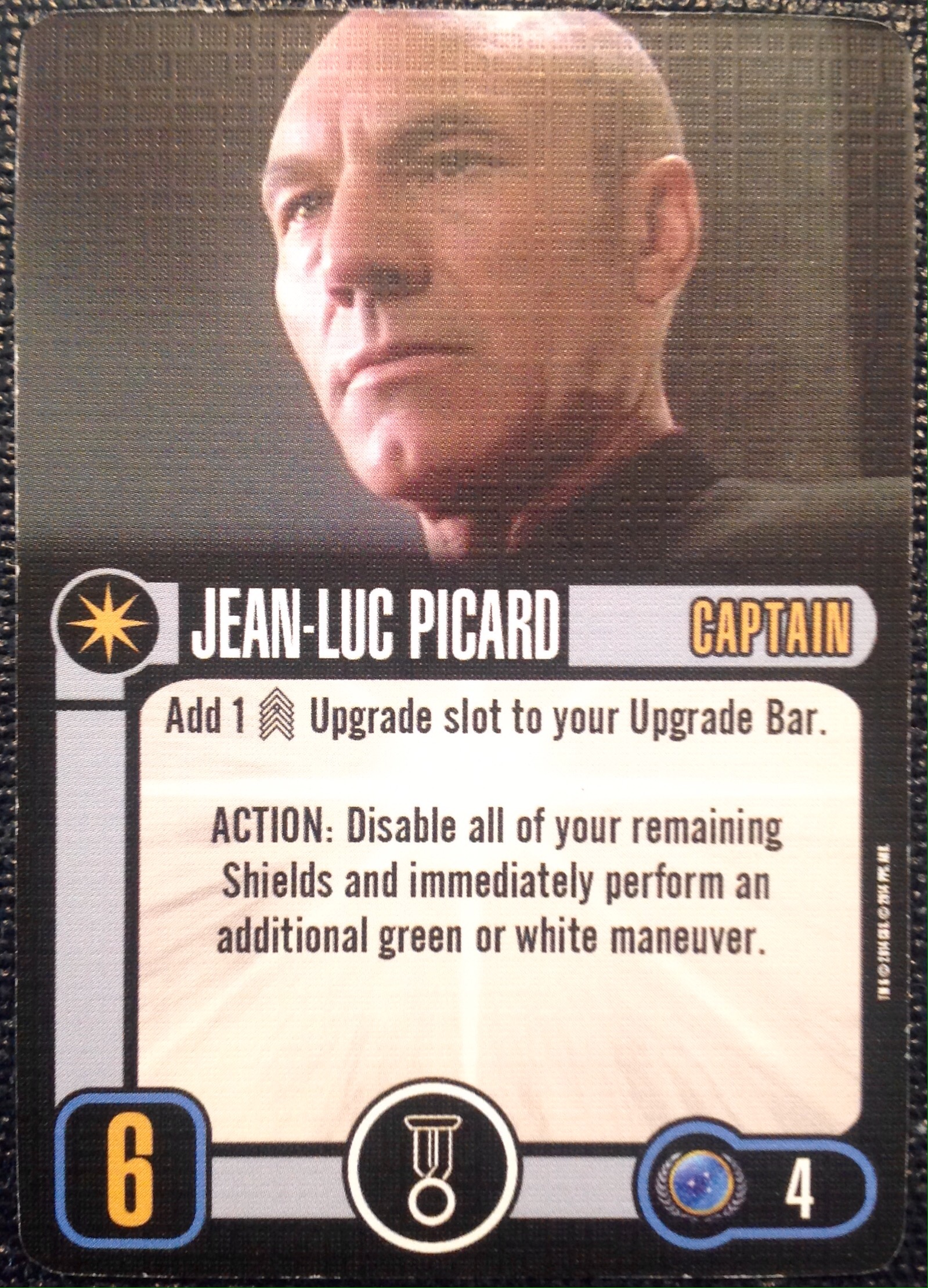
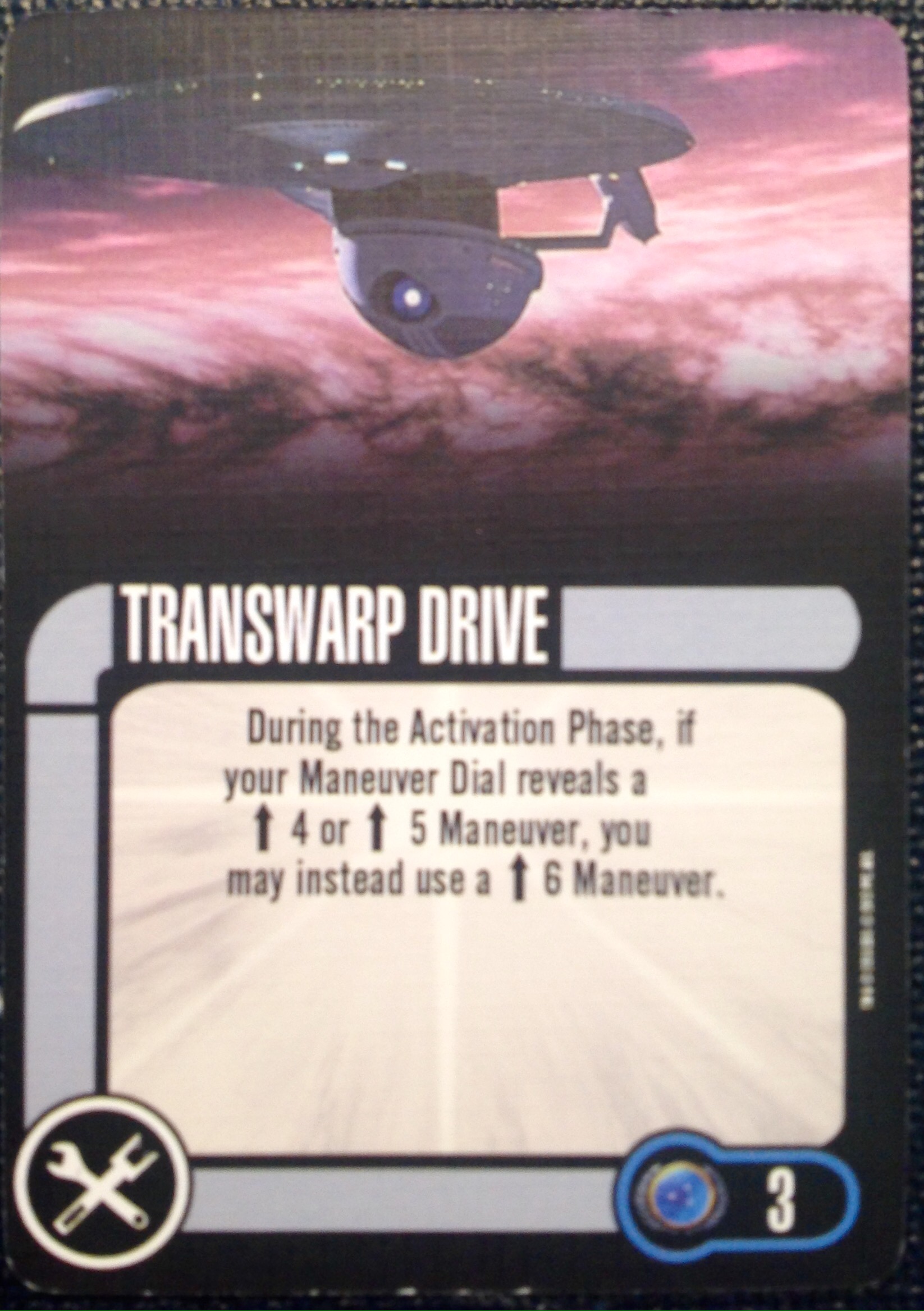
In addition, Captain Picard’s captain Ability will allow an additional STRAIGHT 4. In addition, the Rabbit will be able to use Admiral Forrest’s free movement, as well as the Emergency power.
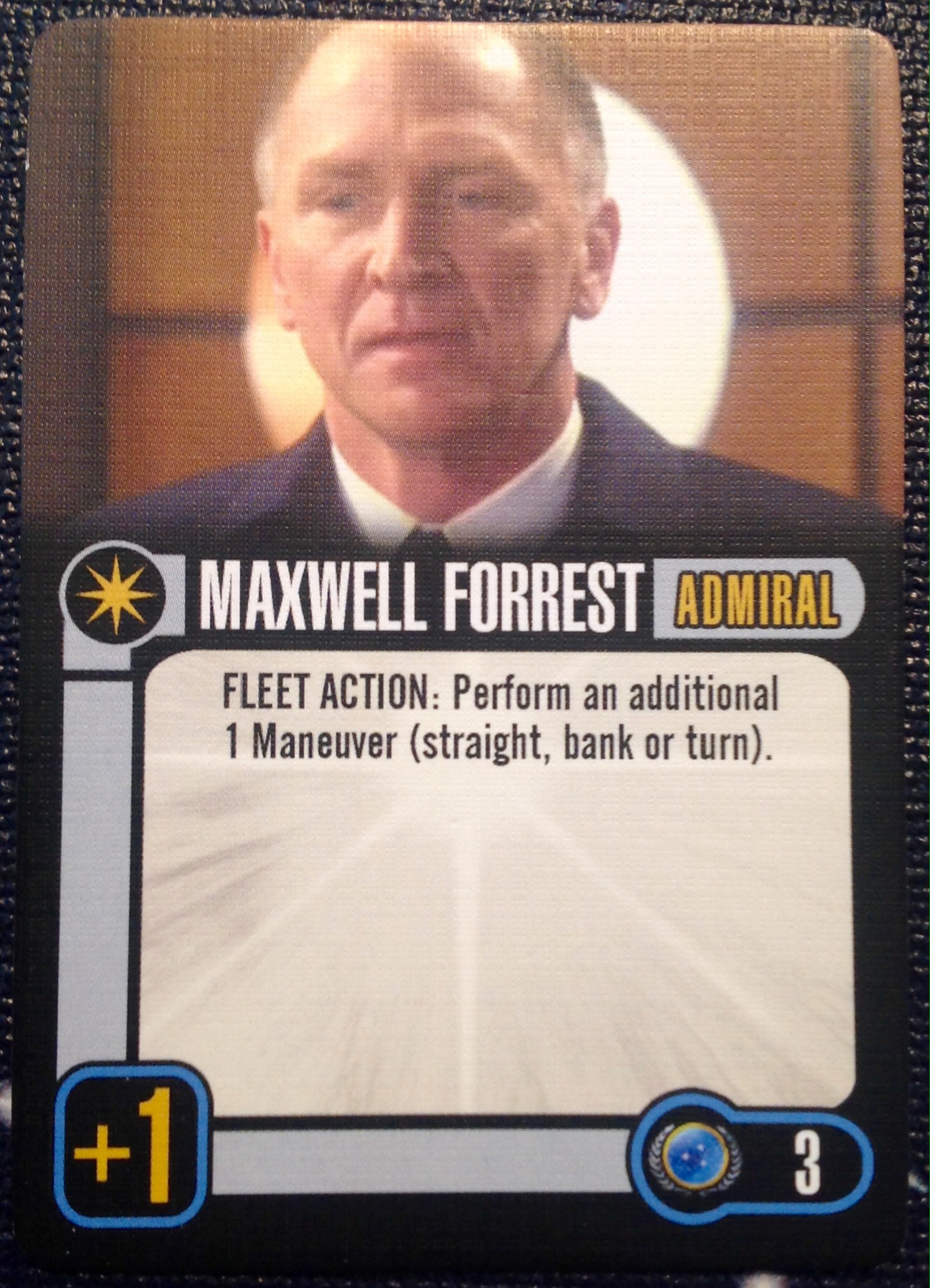
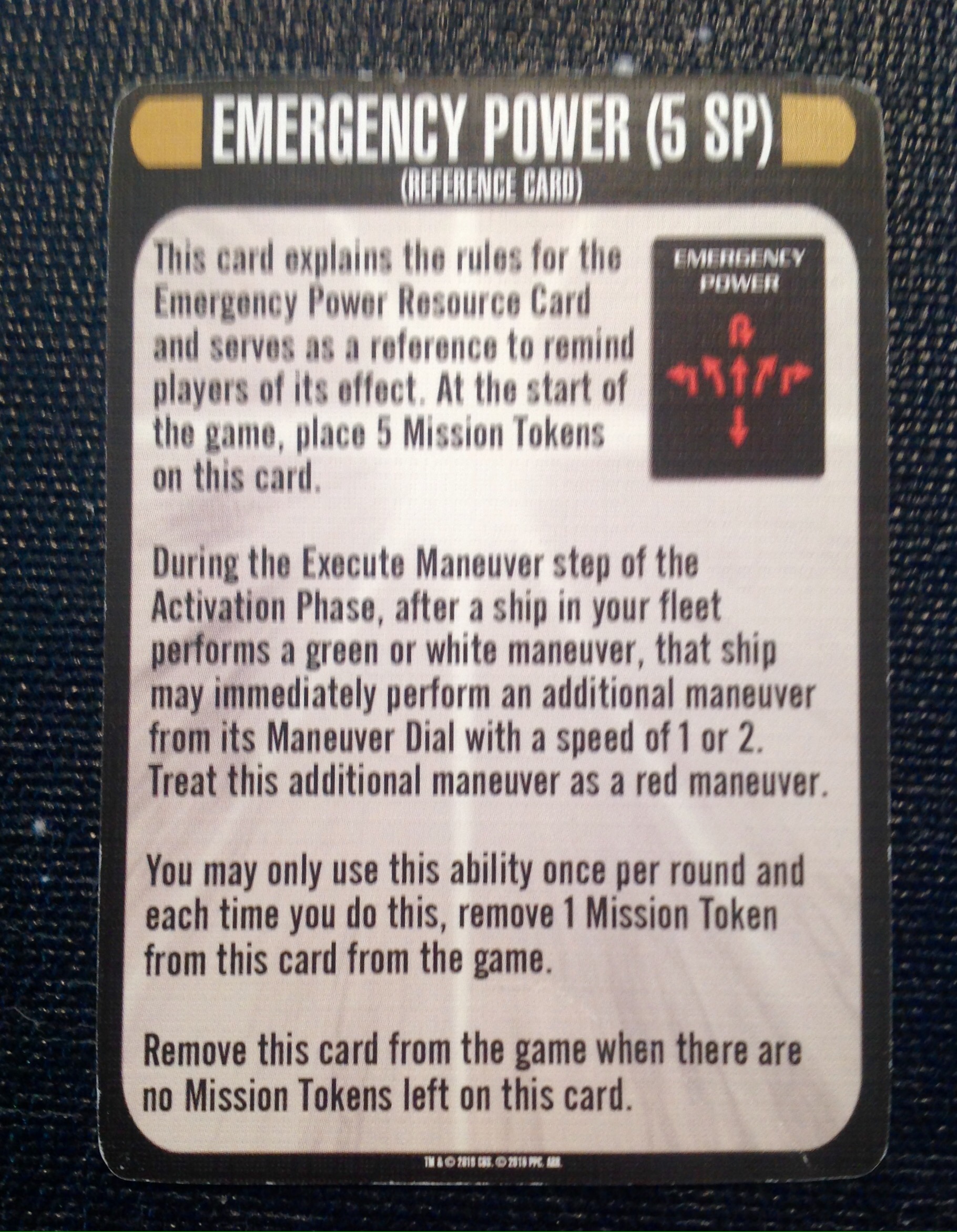
At the beginning I described this as an unbeatable build. Is it beatable? I don’t think so. I played against it and tried using Jennifer Sisko which allowed me to disable two upgrades on the Rabbit. It slowed him only a little. And I had to build a fleet designed to stop him, not necessarily to win.
It’s always possible that a player might still fly badly. In fact, during the Chronological Chaos OP, my son was so anxious that he ended up flying the Rabbit off the board on his first turn. He still won by racing the Prometheus to the end.
But, barring any mistakes in the execution, I don’t think it’s possible to build a fleet that is faster than the Rabbit, and the fact that the Rabbit ends up through two portals before the end of the first Activation Phase means that no one is going to be able to shoot at it. The Prometheus can act as a blocker, disrupting or firing on any ship chasing the Rabbit. The Hathaway, having fulfilled it’s role in the first Activation Phase simply needs to stay out of the way, but even if it gets killed, when the Rabbit hits the fourth portal, the Federation player wins regardless.
This is the second in a series of posts about Star Trek Attack Wing:
Tuesday: An introduction to Star Trek Attack Wing
Wednesday: Chronological Chaos OP: An Unbeatable Build?
Thursday: Throwback Thursday: Winning the Klingon Civil War OPs with more unbeatable builds
Friday: STAW is DEFINITELY Pay-to-play. . .And players should be grateful it is
Enoch Bliss gets the lion’s share of the credit for designing The Rabbit Build.
Rodney M Bliss is an author, columnist and IT Consultant. His blog updates every weekday. He lives in Pleasant Grove, UT with his lovely wife, thirteen children and grandchildren.
Follow him on
Twitter (@rodneymbliss)
Facebook (www.facebook.com/rbliss)
LinkedIn (www.LinkedIn.com/in/rbliss)
or email him at rbliss at msn dot com(c) 2017 Rodney M Bliss, all rights reserved
I’m writing this in January, 2017. You’re reading it sometime after December 2017. It’s my version of a time travel story. Except it’s all true, or might become true. And it’s about me.
I remember reading a short story one time about a time traveller. His world was drowning in pollution and decay. He tells people about his trip to the future. I think it was only 50 years into the future he travelled. Yet, in that time, the world changed. The people had cleaned up the pollution, cleaned the air and saved the world.
The story ends with the time traveller, now an old man attending a celebration. It is now the day on which his past self had visited. The world was just as he’d described it. People eagerly waited for that magical moment when the traveller from the past would arrive and the time traveller would meet his younger self.
The moment came and went, but the time traveller from the past never arrived. Confused the people asked the old man what went wrong.
I lied. I never went to the future.
I cannot find the story now, and I don’t remember who the author was. (Although, it sounds like Arthur C. Clarke, with the twist at the end.)
This is my Time Traveller piece. Here’s how I think the year went, or might have gone.
December 22, 2017
It’s been a good year. Much better than 2016 was. I picked a theme for this year. It was RESOLVE. Not necessarily in terms of New Year’s Resolutions, although there was some of that. Instead I was thinking of resolve in terms of finally resolving some things that have been on my plate for a long time.
Back in April, I finally finished my Bachelor of Science in Information Technology from Western Governors University. I spent a lot of years in school, much of it at BYU studying Computer Science. I’m glad to have it done, and thanks to Amy Stolt, my WGU mentor for her help, and especially my lovely wife for her help and support all these years.
In May we welcomed our fifth grandchild. I love my children and grandchildren. They are both my greatest pride and my greatest heartache, all rolled into one.
I finally had the time and money to get my car, Iron Man, back on the road. Thanks to my neighbor Jonathan Shaw. I couldn’t have done it without him. (And this puppy is finally growing up.)
I spent a lot of time hiking and camping in Utah’s wilderness. I enjoy working with the young 12 adn 13 year old scouts. This year, I was very proud that two of my boys finished the requirements for their Eagle Scout awards. I might have taken them camping, but it was their mother who really got them through this.
Keeping with the RESOLVE theme, I also finally published one of the books I’ve been working on for ages. Self publishing is not as hard as it looks and it looks really hard. Thanks to my friend Howard Tayler for finally showing me how “16 Management Rules that Make No Sense” could become a book. I’m still working on the non-fiction, but this one needed to get done first.
I didn’t get down to Arizona to meet with my friend Steve Hambruch and record my songs, but I did get the music for a few more written out. Maybe next year.
I got to play Star Trek Attack Wing with my brother and my sons. I wrote and published a half dozen scenarios or so.
In November I finished a huge project at work. We moved our phone system to the cloud. It was the biggest project I’ve ever been involved with. It went amazingly well. Now, I have to decide what to do with this new knowledge I’ve gained. There are lots of options. . .all of them good.
Finally, I wrote letters. Actual paper-and-stamp letters. I did that a lot a few years ago and then life got busy. Mostly, I write to my kids. Well, and my friend Brian Christenson, a friend from high school who always writes back.
We’re healthy and happy. My four oldest at home are seniors and looking forward to graduating in June. Life at home will be the same, but then, honestly, it never was.
Happy 2017. Bring on 2018.
Rodney M Bliss is an author, columnist and IT Consultant. His blog updates every weekday. He lives in Pleasant Grove, UT with his lovely wife, thirteen children and grandchildren.
Follow him on
Twitter (@rodneymbliss)
Facebook (www.facebook.com/rbliss)
LinkedIn (www.LinkedIn.com/in/rbliss)
or email him at rbliss at msn dot com(c) 2017 Rodney M Bliss, all rights reserved
I’ve never understood why we use a chain as a metaphore when talking about teams. Chain of command? Sure, that’s a pretty obvious chain. But, a team is more like chainmail, if we need to go with the “linked metal” metaphore. All the pieces depend on all the other pieces. That’s not to say that there cannot be weaknesses in your chainmail.
As managers or team leaders, it’s really tempting for us to identify the weak link, or links. Obviously the weaknesses typically show up when there’s been a breakdown. If there was a screwup, someone is going to notice and generally they want to know what you the team leader, is going to do about it.
Let me start by saying there are times people need to be fired. If an employee steals, or thhreatens another employee. If an employee sexually harrasses another employee or commits a crime, these people often have bigger issues to deal with than their employment. Don’t worry too much about letting these people go. HR will probably force you to regardless.
I’m talking about the times where someone just screwed up. They were supposed to lock up before leaving and didn’t. They were supposed to file paperwork on Monday and they didn’t get it done utnil Wednesday and you missed a deadline because of it.
These are your problems. And I don’t mean the employees are yours therefore their problems are yours. I mean these problems are your problems to fix.
But, Rodney, it was the employee that screwed up, not me. How is this MY problem?
Because, you shouldn’t blame weak links. Being the manager, or the team leader is more than simply running team meetings and approving Personal Time Off (PTO) requests. You are the leader, the coach, the mentor. If something is wrong in your team, it’s your job to fix it.
But you don’t understand, Rodney. I’ve tried coaching. It’s not working.
In that case, the question is which one of you is in the wrong job? If an employee isn’t up to the job, then you owe it to him (or her) and to your company to let them go find something they are good at, or at least competent at. It’s been my experience that most employee failures are a lack of leadership. People work for you to get paid. Let’s not kid ourselves that anyone is at work just because they didn’t really have anything better to do 40 hours per week.
But, as a manager, you need to find how to train and motivate your teams. And it’s not about money. Money is a terrible motivator. For some employees, they respond to praise. Some (much fewer than you would think) respond to repreimands. Some respond to a “fun” atmosphere. Some do best in a quiet corner. It’s your job to know what will work for each employee.
And it’s not going to be the same thing for each of them. You need to figure out what works and then adjust your management style accordingly. If you’ve trained an employee and you’ve used the proper motivation techniques and they still fail to perform to the minimum requirements of their job? It’s time to give them opportunities eleswhere.
So, if there’s a problem with an employee, it’s either a training issue, a motivation issue, or they are in the wrong job. These are all three factors that you, as the manager have 100% control over. So, if your team is underperforming, YOU are the weakest link.
Rodney M Bliss is an author, columnist and IT Consultant. His blog updates every weekday. He lives in Pleasant Grove, UT with his lovely wife, thirteen children and grandchildren.
Follow him on
Twitter (@rodneymbliss)
Facebook (www.facebook.com/rbliss)
LinkedIn (www.LinkedIn.com/in/rbliss)
or email him at rbliss at msn dot com(c) 2017 Rodney M Bliss, all rights reserved
Do you know anyone who does weight training? I’ve never much of a lifter, or bodybuilder, but I know a few. Invariably they hate leg day. They’ll do bench press reps until they drop, but those leg machines are only used grudgingly. Why do they do it? The bodybuilders understand that it doesn’t matter how sculpted the upper body is, if it’s on top of a couple of toothpicks.
Your teams work the same way. As a team leader, you are only as strong as your team. Think about when teams fail. Typically it’s the manager that gets blamed or demoted. Here’s a little secret of management.
You look best as a leader when your teams look successful.
And your team looks successful when the individual members look successful. Let me tell you a tale of two managers. We’ll start with the unsuccessful one.
Allen was a first time manager. He had been a successful engineer and impressed management with his drive, his knowledge and his ability to get stuff done. Management formed a new team to focus on high value accounts. They tasked Allen with being the team lead.
Allen’s team was made up of people like him. His team members were highly driven, experienced and had a history of getting things done. It seemed like a perfect setup. However, Allen failed to realize that when you transition from team member to team manager. As a team member, or individual contributor, you are expected to get results, to see problems and attack solving them. Depending on your team, you may be expected to be the guy (or girl) who actually jumps in and gets the results.
The most successful people I’ve worked with have a “tank driver” mentality. Give them an objective and point them in the right direction and then get out of th eway lest you get run over. They see obstacles as a challenge.
The merely difficult we get done immediately. The impossible takes slightly longer”
The military calls these types “High speed/low drag.”
But, as manager, you have to almost take the complete opposite point of view. You cannot just do it all yourself. If you could, they would not have given you a team to work with. And if you are the team lead it’s typically because you were really good at doing stuff. In fact, you are probably better than your team members at doing stuff than they are. It’s tempting at times to step in and just “do it.”
Don’t do it.
Allen, became frustrated with the actions of his team. See, he had a particular method to his success. He couldn’t understand why his team didn’t adopt that same method. If they would just do it his way, they would be more successful. After all, that’s how he became successful. As time went on, it got worse. The worse it got the harder he worked at “managing.” At one point he stated, “Rodney, you don’t own your account. I do. You just work on it.”
Unfortunately for him, he was wrong. It was a multimillion dollar account that I’d managed for years. The ironic thing was that not just me, but all of us on the team would have been thrilled to make him look good. If he’d let us work our accounts our team would have become wildly successful. As the manager, he would have gotten credit for that. And he wouldn’t have had to ask. People just would have remarked, “Have you noticed how successful Allen’s group is?” But, by not empowering his team, he achieved just the opposite results.
Let me tell you about a different manager. Staci had been managing director of a group of 40 people at the company she worked at before Microsoft. However, the chance to work for Microsoft in the 1990’s was a powerful draw and she accepted a team manager position. There were 7 of us on the team. Staci made the conscious decision to work on promoting her team over attemtping to burnishing her own star.
She individually mentored each of us. She looked for opportunities for us to have an impact on the bigger department. She constantly talked us up to her peers and management. We responded. Each of us was focused on making the team look good and being successful. And it paid off. When bonus time came around we all got bonuses and many of us got promotions.
But, what about Staci? She had ignored her own “career development” for the yearin order to promote her team. She got the biggest bonus of us all.
If you want to be successful, strengthen your team. Make sure they get the accolades and the glory for success and ironically, you will be viewed the most successful of all.
Rodney M Bliss is an author, columnist and IT Consultant. His blog updates every weekday. He lives in Pleasant Grove, UT with his lovely wife, thirteen children and grandchildren.
Follow him on
Twitter (@rodneymbliss)
Facebook (www.facebook.com/rbliss)
LinkedIn (www.LinkedIn.com/in/rbliss)
or email him at rbliss at msn dot com(c) 2017 Rodney M Bliss, all rights reserved

Let me be a little self-indulgent for a minute. I know that’s an odd request from me since blogs are the ultimate self-indulgent vehicle. “Here let me tell you about me and my thoughts. . .”
In truth, I try each day to find something that will be interesting, or at least entertaining to you, dear readers. Your time is valuable and I try to never waste it. While I write for me, I always have you in mind as I consider what stories to put down.
Not today. Today, it’s about me. Well, me and the person who puts up with me the most. See, today is my wedding anniversary. And not just any anniversary. Thirty years ago today, I was a scared, scawny kid of 22 years old headed to the LDS temple in Seattle, Washington to marry a woman that I thought I wanted to spend the rest of eternity with. If I was young, she was practically a baby. She had just turned 19, and she was gorgeous.
We met at a church softball game four years earlier. Growing up Mormon in the Olympia, Washington area, all the Mormon kids knew yeach other. She grew up in Yelm, I was from Lacey, but we were part of the Olympia Washington LDS Stake. I went off to serve a two year LDS mission and she finished growing up.
We both ended up at BYU. As the semester came to a close, I found myself in the Computer Science lab desperately trying to get my final program to compile and run. She was in the same class. She finished her program and offered to help me finish mine. That night we went out to eat at a Subway Sandwiches restaurant. It rekindled a friendship that grew into something more.
We were married almost exactly a year later. It was the break between school semesters. Seattle was beautiful that December day. The weather had broken and we had blue skies and highs in the 60s.
In the ensuing years we’ve had lots of ups and down. We’ve been fabulosuly wealthy and dirt poor. We added children, first by birth and then through multiple adoptions. Recently, we’ve added grandchildren. We’ve been to the far side of the world together. We’ve seen tragedy and triumph. Through it all, we’ve had each other.
I’ve never looked twice at another woman. I was surprised when she agreed to marry me and have been counting my blessings for the past three decades. She’s smarter than me, better looking, a better cook, more patient, more caring, more spiritual, and pretty much a better person in every way.
May each of you be lucky enough to find someone even half so wonderful to share your life with. You’ll be rich indeed.
Rodney M Bliss is an author, columnist and IT Consultant. His blog updates every weekday. He lives in Pleasant Grove, UT with his lovely wife of 30 years, thirteen children and grandchildren.
Follow him on
Twitter (@rodneymbliss)
Facebook (www.facebook.com/rbliss)
LinkedIn (www.LinkedIn.com/in/rbliss)
or email him at rbliss at msn dot com(c) 2017 Rodney M Bliss, all rights reserved
I didn’t want to write this. Net Neutrality passed two years ago and despite being a voracious reader and basic news gadfly, I managed to ignore it. I knew it was potentially changing the way we use the internet, but I was busy. Besides, win or lose, I wasn’t going to change my behaviors based on Net Neutrality.
So, I ignored it. And you know what? Nothing happened. I mean to me personally. I congratulated myself on skipping at least one controversy.
And then, of course it came back. Or rather, it went away. Last week the Federal Communication Commission voted to abandon Net Neutrality. Some people took it really hard.
First though, what is it? This isn’t the definitive description, but it was a rule that said Interent Service Providers had to treat everyone equally. That seems fair right? They couldn’t decide they don’t like you, or your favorite website and charge you more to access it, or worse, slow down traffic to your favorite site. Everyone equal. Fair is fair.
Except there were a couple of problems with it. First, fair isn’t fair. The FCC under the previous administration decided that access to the internet needed to regulate like a public utility. Your electric company cannot decide that they are going to charge you a higher rate than your neighbor. The gas company can’t decide that they want to charge you less because you don’t have a gas furnace. The water company cannot decide that since you live in a 4000 square foot home, you have to pay double what the family in the 2000 square foot home pays. Fair is fair. Why not ensure the internet is treated the same way?
Because it’s not the same thing. Suppose the government decided to force other businesses to act like commodities. WalMart is no longer allowed to charge less the same stuff as your corner market. If you want to buy a book, the Amazon price needs to be the same as the neighborhood bookstore. Fair is fair, right?
Wrong.
The market does a pretty good job of setting prices. But, what about companies like Netflix that use a lot of bandwidth. Without Net Neutrality, your ISP could charge you more for Netflix traffic than it does for CNN.com. Is that fair? Absolutely. Why? Because it means that ISPs can optimize their throughput for what their customers actually want to buy. Scarity results in higher prices. But, prices do not rise infinately and they do not rise arbitrarity. The market will set a price where supply and demand match. If an ISP prices Netflix traffic separately and it’s too high? People will abandon the ISP, or they will yell and scream at the ISP. Either way, the ISP, if it wants to keep happy customers, will change it’s pricing.
But, what about places where there is a single ISP that has a monopoly? This is why I didn’t notice anything two years ago. My ISP is a local guy who supplies just our town. If he charges too much, I’ll switch to something else. But, what if there is nothing else?
There is. Most people I know do the majority of their internet browsing through their cell phones. With 5G on the horizon, and cell phones able to act as WiFi routers, it will be less than a year and phone companies will be competing with your local ISP to provide you internet access. You’ve already ditched your local phone for your cell phone, your local internet isn’t far behind.
Put me in the anti-net neutrality camp.
Senate Minority leader Chuck Schumer has claimed that the Senate will vote to reinstate Net Neutrality. And that’s actually my other problem with the rule. It was not implemented by Congress. It was an executive order from the previous administration. The current administration didn’t need to repeal a law because Net Neutrality was never subjected to the necessity of getting voted on in Congress.
I am not a big fan of the president unilaterally passing “laws.” Even when it’s a president I woudl otherwise support, I don’t think it’s the role of the Executive Branch of the Federal Government to make laws. Ironically, the mechanism to remove Net Neutrality was the same mechanism used to implement it in the first place.
Fair is fair.
Rodney M Bliss is an author, columnist and IT Consultant. His blog updates every weekday. He lives in Pleasant Grove, UT with his lovely wife, thirteen children and grandchildren.
Follow him on
Twitter (@rodneymbliss)
Facebook (www.facebook.com/rbliss)
LinkedIn (www.LinkedIn.com/in/rbliss)
or email him at rbliss at msn dot com(c) 2017 Rodney M Bliss, all rights reserved
I spent last week in Lexington Kentucky. Much of the time I was bored. I frequently wondered if I was really essential to my project.
Everyone had a task to do. Darcy was responsible for helping the agents move from one system to the other. Jeram was responsible for making sure the computers were properly set up. Reggie was responsible for making sure that all of the reports got done. There really wasn’t a task for Rodney. And yet, I was the most important person there… Or so they said.
I’ve been working on this project for over a year. It has consumed vacation time, family time, personal time and just about anything else that it could intrude upon. So why was there nothing for me to do now that we were moving the agents to the new system?
Planning.
Preparation.
Those were my responsibility. And had I done them poorly we would have had crises show up during the migration. The fact that there were only minor if any crises meant that we had properly prepared. Our planning has been sufficient. And that’s the irony. By doing my job well over the past 12 months I worked myself out of a job during the actual migration itself.
I was essential to the project. I was also fortunately worthless during the migration. It’s one of the first times I can ever remember being essential and worthless at the same time.
Rodney M Bliss is an author, columnist and IT Consultant. His blog updates every weekday. He lives in Pleasant Grove, UT with his lovely wife, thirteen children and grandchildren.
Follow him on
Twitter (@rodneymbliss)
Facebook (www.facebook.com/rbliss)
LinkedIn (www.LinkedIn.com/in/rbliss)
or email him at rbliss at msn dot com(c) 2017 Rodney M Bliss, all rights reserved
Yesterday, I talked about traipsing around Laurel County, Kentucky with Shirley, my fourth cousin. . .once removed. Here are some of the pictures.

Laurel County is located in South East Kentucky. My family arrived in the area in the early 1800’s.

This is the Campground Cemetery. The graves of William Blair and Jane Blair are in the foreground.

William was born in 1800 in Virginia and passed away 70 years later in Laurel County

His wife Jane, passed away in 1866

Cousin Shirley has lived here her whole life. The fifth generation of our family to live in these hills

The Campground Methodist Church has stood in this spot for more than 150 years

Great-great-great-great-grandfather Reverend James preached here. In fact, our family members were some of the charter Me members
Rodney M Bliss is an author, columnist and IT Consultant. His blog updates every weekday. He lives in Pleasant Grove, UT with his lovely wife, thirteen children and grandchildren.
Follow him on
Twitter (@rodneymbliss)
Facebook (www.facebook.com/rbliss)
LinkedIn (www.LinkedIn.com/in/rbliss)
or email him at rbliss at msn dot com(c) 2017 Rodney M Bliss, all rights reserved
I didn’t know her, this older woman whom I’d arranged to meet in a deserted parking lot in South Eastern Kentucky. She pulled her black Toyota Forerunner to a stop behind my white Ford Mustang. She expressed not the least nervousness as she greeted each other.
Climb in. I’ll drive. You don’t know where we’re headed.
Her name was Shirley. I knew that from the emails we’d sent back and forth. We headed off into the rolling hills of Eastern Kentucky. There was very little we had in common that wasn’t more than 150 years old. We were cousins. Both descended from people who had lived in these hills and hollows since the early part of the 19th century. My people had left to travel West in the mid 1800’s. Her people stayed. The person we had in common was William Blair. He was born in 1800 and had moved his family to Kentucky from Virginia. William had a son named James. His son was another William. William’s son Tandy was my great grandfather. Our family were charter members of several churches in the London, Kentucky area.
One is closed and is for sale for $100,000. Others are still active. We drove from to a hill top cemetery. The highest point in Laurel County or so says Cousin Shirley. She’s my grandmother’s age. Or, the age my grandmother would be if she were still alive. Granny made this trip to Laurel county before she died. Cousin Shirley spoke fondly of their conversations and explorations of Blair family history.
We compared notes. These were my mother’s people. And her mother’s before her. It was my great-grandfather’s family. His father’s father was also cousin Shirley’s ancestor. We realized we are 4th cousins. . .once removed. It’s actually pretty easy to find the “cousin” relationship with a relative. In this case, our common ancestor was William Blair, my great-great-great-grandfather. He is Cousin Shirley’s great-great-grandfather. Once you find the common ancestor, just walk down the relationship line to find your cousins. If you have the same common ancestor, you are siblings. If your ancestor was two generations back (your grandparent), you are cousins, or more accurately 1st cousins. If the common ancestor is back three generations, you are 2nd cousins. And so on. Once you find your “cousin-ness” then the “removed” is for situations where one person is closer to the common progenitor than the other. My mother and Cousin Shirley are 4th cousins. Since I’m one generation removed from my mother, we are 4th cousins once removed.
It was a wonderful day in the hills of my ancestors. I learned that an ancestor Christopher Cooper was a Revolutionary War soldier. I learned that when the Civil War ripped the country apart, my people, our people fought for the Union. It doesn’t change who I am here in the 21st Century, of course, but it was nice to know that we were on the right side of history.
Too soon the day was over and it was time for me to head back to my hotel in Louisville. I took pictures back with me, but more importantly, I took stories. Stories that I can tell my children and grandchildren. So, if someone asks, “Where are we from?” One of the answers will proudly be “We’re from Laurel County, Kentucky.”
Just a bunch of hillbillies, really.
Rodney M Bliss is an author, columnist and IT Consultant. His blog updates every weekday. He lives in Pleasant Grove, UT with his lovely wife, thirteen children and grandchildren.
Follow him on
Twitter (@rodneymbliss)
Facebook (www.facebook.com/rbliss)
LinkedIn (www.LinkedIn.com/in/rbliss)
or email him at rbliss at msn dot com(c) 2017 Rodney M Bliss, all rights reserved
